Paul van Yperen's Blog, page 199
April 24, 2020
New Acquisitions: Early Pathé Stars
Ivo Blom found this series of French postcards of the 1910s. The publisher is unknown but we guess it was Pathé Frères while all the portrayed actors and actresses worked for Pathé in the 1910s. Most of the photos were taken by A. Bert or Félix, who both also worked for other postcard series by Pathé. The numbers on the cards double, so there were probably two or even more series.
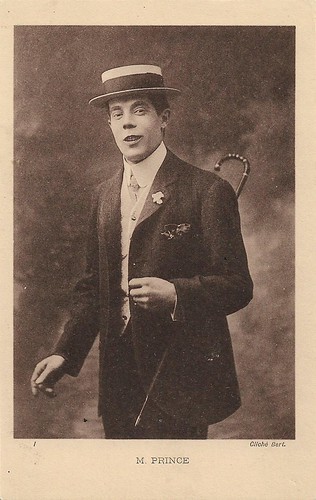
French postcard, no. 1. Cliché Bert.
Charles Prince (1872-1933), aka just ‘Prince’, was a French film actor, director, and writer. He was famous for his countless comical shorts with his alter ego Rigadin.
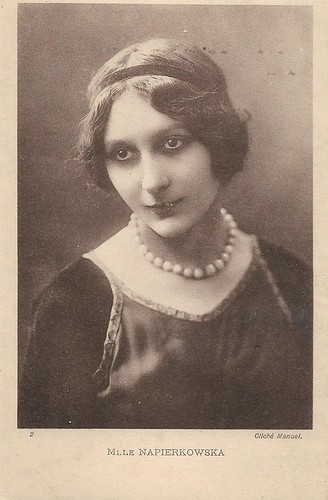
French postcard, no. 2. Cliché Manuel.
Exotic Stacia Napierkowska (1886-1945) was a fascinating star of the silent film era. The French actress and dancer is best remembered as the seductive but cruel Queen Antinéa in the classic fantasy L’Atlantide/Queen of Atlantis (Jacques Feyder, 1921). Between 1908 and 1926 she appeared in 86 films.
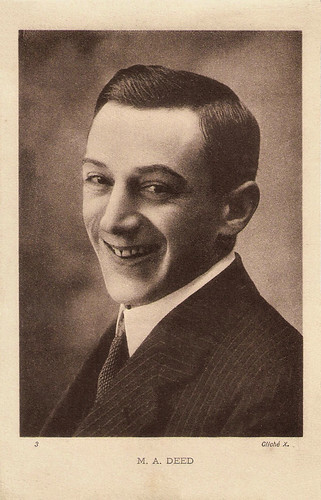
French postcard, no. 3. Cliché X.
André Deed (1879-1940) was one the most popular comedians in French and Italian silent cinema under the names of Boireau and Cretinetti. He also was a film director and scriptwriter.
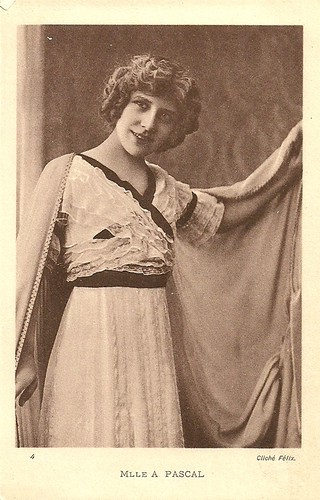
French postcard, no. 4. Cliché Félix.
Andrée Pascal (1892-1982) was a French actress who was highly active in French silent cinema. She did over 30 films for Pathé in the early 1910s but suddenly stopped her film career after acting in L'empereur des pauvres (1922).
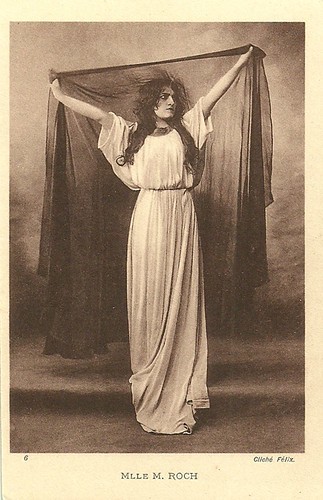
French postcard, no. 6. Cliché Félix.
Madeleine Roch (1883–1930) was a reputed French 'tragédienne' from the Comédie Française, who between 1909 and 1913 acted in a series of 11 Film d'Art-like historical films at Pathé Frères. These included the Tolstoy adaptation Résurrection (1909), Messaline (Ferdinand Zecca, Henri Andréani, 1910), Cléopâtre (Ferdinand Zecca, Henri Andréani, 1910), Moïse sauvé des eaux (Henri Andréani, 1911), Radgrune (Camille de Morlhon, 1911), and Une intrigue à la cour d’Henry VIII (Camille de Morlhon, 1911). Madeleine Roch entered the Comédie-Française in 1903 and was a Sociétaire there between 1912 and 1930. Her quitting of film acting in 1912 may have had to do with becoming a Sociétaire. She was in particular a performer of the plays of Jean Racine, such as 'Andromaque', 'Brittanicus', and 'Phèdre', and of Greek tragedy. At the open air Théâtre des Arènes in Béziers, she starred in e.g. 'Le premier glaive' (1908), 'La fille du soleil' (1909), 'Héliogabale' (1910), and 'Les esclaves' (1910). In 1930, Roch gave her last stage performance. She died that same year.
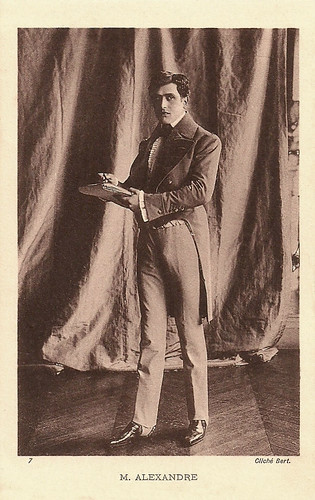
French postcard, no. 7. Cliché Bert.
René Alexandre (1885-1946) was a French actor of the Comédie-Française. Between 1909 and 1940 he acted in some 53 films, mainly in shorts by Pathé but also om Antoine’s rural drama La Terre (1921).

French postcard, no. 7. Cliché Boyer.
Louis Ravet (1870-1933) was a French stage and screen actor. Ravet, who first acted at the Théâtre des Bouffes du Nord and the Théâtre de l'Ambigu-Comique, was pensionnaire of the Comédie-Française from 1899 to 1919, playing in the classics by Corneille, Hugo, and most often, Racine.
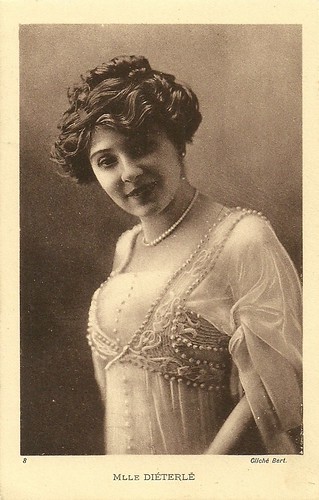
French postcard, no. 8. Cliché Bert.
Amélie Diéterle (1871-1941) was one of the most beloved actresses and singers of the Belle Epoque, who inspired poets and painters such as Mallarmé and Rodin. Between 1909 and 1913 she acted in some 27 shorts films at Pathé Frères: mostly Rigadin comedies directed by Georges Monca.
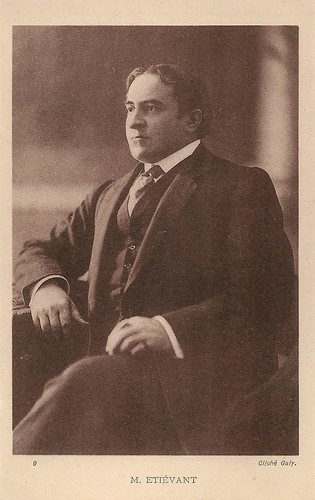
French postcard, no. 9. Cliché Gully.
Henri Étiévant (1870–1953) was a French actor, who started at Pathé Frères in 1908 and had a prolific career there until 1914, often - but not always - playing bad guys. In the four-part episode film Les misérables (Albert Capellani, 1913), he played Javert, the police commissioner pursuing Jean Valjean ( Henry Krauss ). In 1913, Henri Étiévant worked as a film director at Milano Films, in films with Pina Fabbri, Livio Pavanelli , and Thea Sandten. In 1913-1914, he also worked as a director in Germany for the company Vitascope, in films such as Pauline (1914), often with Sandten in the lead. Between 1915 and 1919, Henri Étiévant was absent from the sets, both as actor and director. In 1920 he retook his career as a director with the film Neuf. In the 1920s, he sporadically returned to the film sets but rather focused on directing, with films such as La fille de Camargue (1921) with Stacia Napierkowska and Charles Vanel , La fin de Monte-Carlo (1927) with Jean Angelo and Francesca Bertini , and La sirène des tropiques (codirected with Mario Nalpas, 1927) with Josephine Baker . With Nalpas he also co-directed his last film, the late silent film La symphonie pathétique (1930). He would still act in five sound films in the 1930s, such as the comedy La bande à Bouboule (Léon Mathot, 1931).
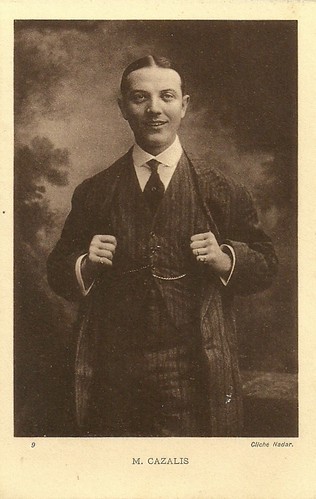
French postcard, no. 9. Cliché Nadar.
Lucien Cazalis (1878-1945) was a French stage and screen actor and singer. In the early 1910s, he was a popular Pathé comedian as the characters Jobard (1911) and Caza (1913-1916).
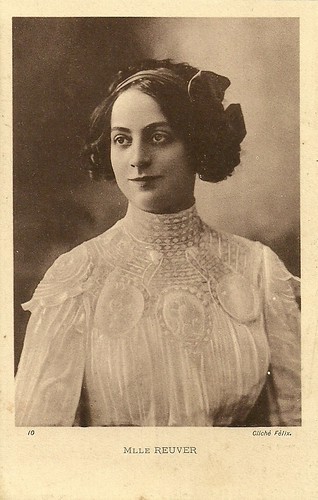
French postcard, no. 10. Cliché Félix.
Germaine Reuver (1885-1953) was a French actress, who acted in some 65 films between 1908 and 1953. Between 1909 and 1912, she often acted in the Rigadin comedies by Pathé. In the 1930s, she played many supporting parts in French sound cinema.
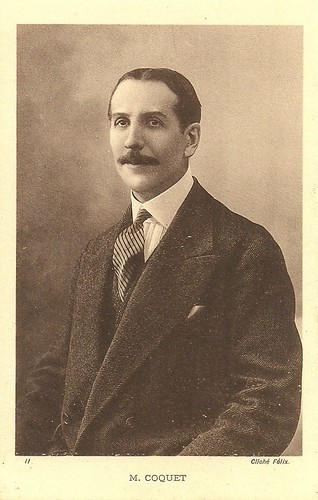
French postcard, no. 11. Cliché Félix.
Georges Coquet (?-?) was a French stage and screen actor. Coquet obtained his diploma at the Paris Conservatory in 1888. He first played classical stage roles, then moved over to vaudeville, and finally played at the Comédie-Française. After a first part in the Pathé thriller La main (1907), Coquet became a prolific Pathé actor between 1911 and 1914, mostly playing in comedies, e.g. those with Max Linder . He was married to Andrée Marly, with whom he also acted together in a number of Pathé shorts such as Deux vieux garçons (Michel Carré, 1911), Le Vase brisé (1912), Serment de fumeur (Camille de Morlhon, 1912), and À la française (1912). In 1912 René Leprince directed Coquet several times, such as in Le club des élégants and L'infidèle. Probably his last part Coquet had in the Gaumont comedy L'épreuve (Louis Feuillade, 1914), starring Renée Carl.
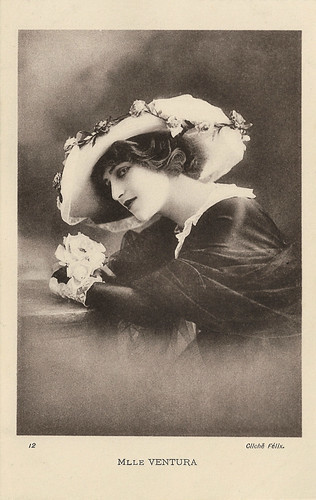
French postcard, no. 12. Cliché Félix.
Marie or Maria Ventura (1888-1954) was a Romanian-French actress and theatre director. She became well known in the silent cinema with her role in the popular serial Les misérables (1912). From 1919 till 1941, she worked at the Comédie-Française. In 1938, she directed 'Iphigénie' by Racine, becoming the first woman to direct a play at the Comédie-Française.
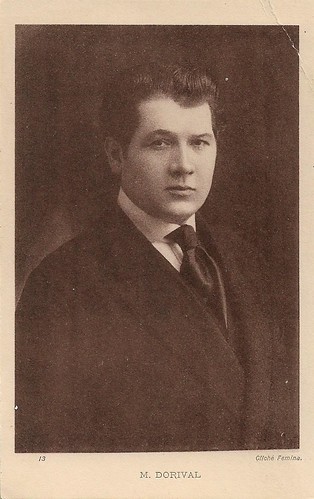
French postcard, no. 13. Cliché Femina.
Georges Dorival (1871–1939) was a French actor, who had a prolific career at Pathé Frères between 1909 and 1914, acting in 26 historical and modern dramas, such as Le bossu (André Heuzé 1912) and Rocambole (Georges Denola, 1914). In the 1920s he did only one film: Quatre-vingt-treize (André Antoine, 1921), in the 1930s five films.
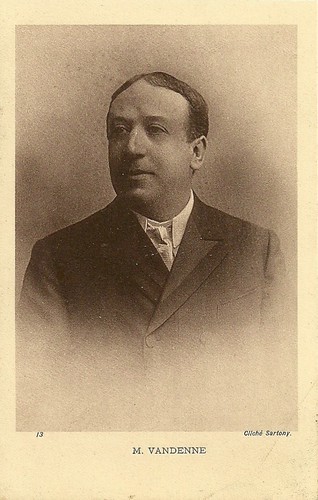
French postcard, no. 13. Cliché Sartony.
Jean-Joseph-Dieudonné-Léonard Van den Kerckhove, known as Jacques Vandenne or simply 'Vandenne' (1864-?) was a French silent cinema actor, mainly at Pathé Frères. He was sometimes indicated as Maurice Vandenne.
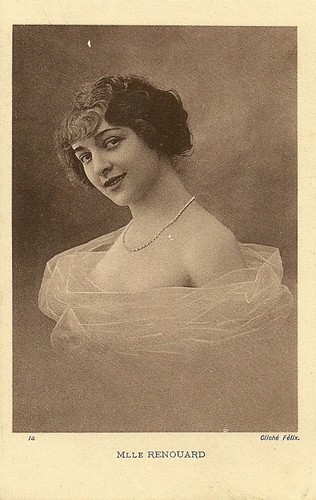
French postcard, no. 14. Cliché Félix.
Jane Renouardt aka Jane Renouard (1890–1972), born Victorine Catherine Renouard, was a French actress of the silent screen. She played Jane, the partner of Max Linder , in many of his short comedies for Pathé Frères. During the First World War, she acted in various feature films, such as the pantomime L'Enfant prodigue (Michel Carré, André Wormser, 1916) with Cécile Guyon as Pierrot and Renouardt as 'his' beloved Phrynette, and the tragedy Clown/Le Clown (1917) by and starring Maurice de Féraudy , as an old clown who kills himself for his son (René Rocher). In 1919 Renouardt did her last film, En quatrième vitesse (Marcel Simon, 1919). She was the first manager of the Theater Danou, which opened in 1921. In 1936 she married the actor Fernand Gravey .
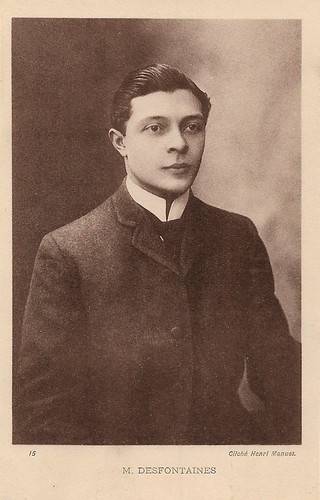
French postcard, no. 15. Cliché Félix.
Jeanne Provost (1897-1980) was a member of the Comédie-Française only between 1907 and 1912, and she would act in some 25 silent and sound films.
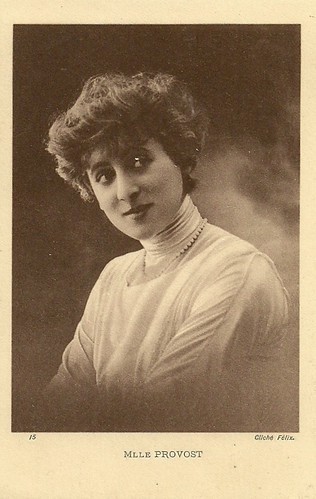
French postcard, no. 15. Cliché Henri Manuel.
Henri Desfontaines (1876–1931) was a prolific actor and director at Pathé Frères between 1909 and 1914, mostly with historical or contemporary dramas. All in all, he acted in 37 films between 1908 and 1920 (plus two early sound films) and directed 61 films between 1908 and 1928. While initially rather acting in films directed by Albert Capellani, he soon became a prolific director as well. In the early 1910s, Desfontaines often co-directed Film d'Art dramas such as L'assassinat d'Henri III (with Louis Mercanton, 1911), Madame Sans-Gêne (with André Calmettes, 1911) with Réjane , Les amours de la reine Élisabeth/Queen Elizabeth (with Mercanton, 1912) starring Sarah Bernhardt , Adrienne Lecouvreur (with Mercanton, 1913) again with Bernhardt, and Anne de Boleyn (with Mercanton, 1914). Probably his first feature-length film was La reine Margot (1914), starring Léontine Massart as Marguerite of Valois, Desfontaines as king Charles IX, Jeanne Grumbach as Catherine de Medici, and Paul Numa as Henri of Navarra. From 1920 onward, Desfontaines focused on film directing, such as L'espionne aux yeux noirs (1926) with Maria Dalbaicin, and Belphegor (1927) with René Navarre .
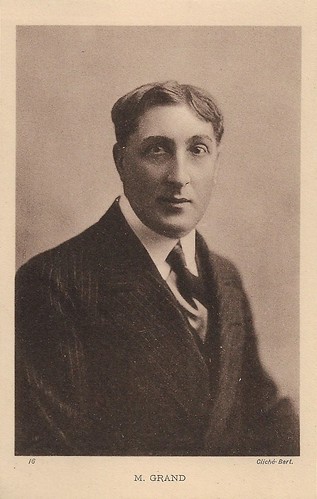
French postcard, no. 16. Cliché Bert.
French stage and screen actor Valentin Pierre Louis MacLeod is better known as Georges Grand (1864-1921). He was first acclaimed for his work with André Antoine before becoming a reputed member of the Comédie-Française. Grand also acted in 11 modern and historical dramas by Pathé Frères.
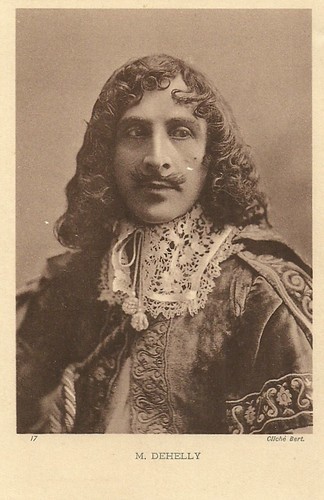
French postcard, no. 17. Cliché Bert. Émile Dehelly as D'Artagnan in Les trois mousquetaires (Henri Pouctal, 1913), based on Alexandre Dumas' famous novel.
Émile Dehelly (1871-1969) was a French stage and screen actor, who was a sociétaire of the Comédie-Française (1903-1928) and had a prolific career at Le Film d’Art between 1909 and 1913. He is the father of film actor Jean Dehelly (1896-1964).
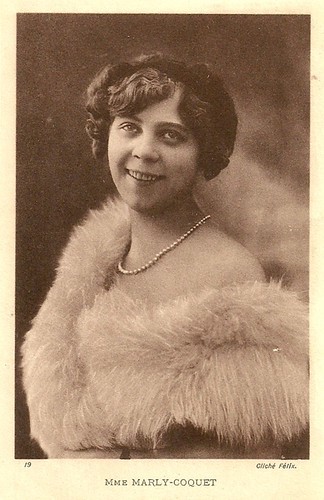
French postcard, no. 19. Cliché Félix.
Andrée Marly (?-?) had a short but intense film career in the years 1909-1916, mostly acting in short comedies and dramas by Pathé. She was married to the actor Georges Coquet.
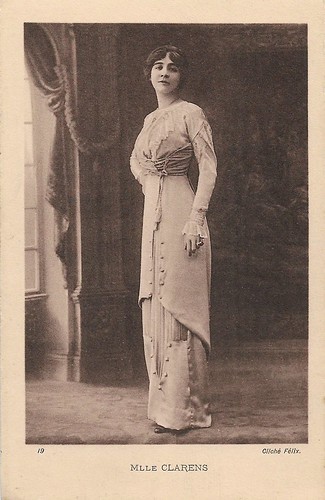
French postcard, no. 19. Cliché Félix.
Juliette Clarens (1887–1978) was a French actress who acted in some 35 films between 1910 and 1920. In 1910-1914, she played in many comedies, e.g. with Rigadin, and dramas at Pathé Frères. In Louis Feuillade's crime serial Judex (1916) she played Gisèle. In Henri Pouctal's Zola adaptation Travail (1920) she was Suzanne.
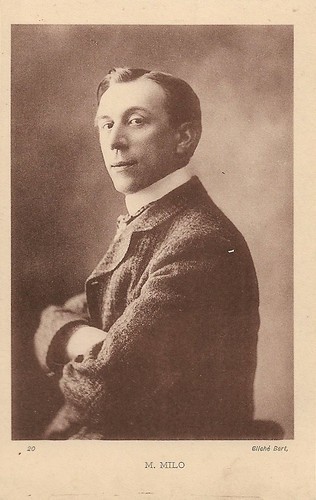
French postcard, no. 20. Cliché Bert.
Émile Mylo aka Milo (1889–1952) was a French actor, who started at Pathé Frères in 1909 and made many shorts there, both dramas and comedies, e.g. the burglar in L'épouvante (Albert Capellani, 1911), starring Mistinguett , the title character in Les aventures de Cyrano de Bergerac (Albert Capellani, 1912), and Thenardier in Capellani's four-part episode film Les misérables (Albert Capellani, 1913). From his later - feature - films his part as Hyacinthe, named Jésus-Christ, in La terre (André Antoine, 1920) was memorable. All in all he acted in 66 films.
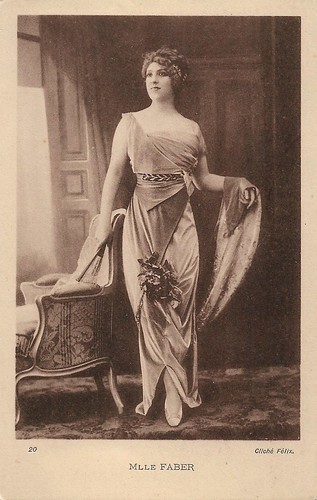
French postcard, no. 20. Cliché Félix.
Jane Faber (1880-1968) was a Belgian actress, who was active in French cinema of the 1910s and is best known for her role as Princess Sonia Danidoff in the Fantomas crime serial (1913-14). She was also a notable actress of the Comédie-Française.

French postcard, no. 1. Cliché Bert.
Charles Prince (1872-1933), aka just ‘Prince’, was a French film actor, director, and writer. He was famous for his countless comical shorts with his alter ego Rigadin.

French postcard, no. 2. Cliché Manuel.
Exotic Stacia Napierkowska (1886-1945) was a fascinating star of the silent film era. The French actress and dancer is best remembered as the seductive but cruel Queen Antinéa in the classic fantasy L’Atlantide/Queen of Atlantis (Jacques Feyder, 1921). Between 1908 and 1926 she appeared in 86 films.

French postcard, no. 3. Cliché X.
André Deed (1879-1940) was one the most popular comedians in French and Italian silent cinema under the names of Boireau and Cretinetti. He also was a film director and scriptwriter.

French postcard, no. 4. Cliché Félix.
Andrée Pascal (1892-1982) was a French actress who was highly active in French silent cinema. She did over 30 films for Pathé in the early 1910s but suddenly stopped her film career after acting in L'empereur des pauvres (1922).

French postcard, no. 6. Cliché Félix.
Madeleine Roch (1883–1930) was a reputed French 'tragédienne' from the Comédie Française, who between 1909 and 1913 acted in a series of 11 Film d'Art-like historical films at Pathé Frères. These included the Tolstoy adaptation Résurrection (1909), Messaline (Ferdinand Zecca, Henri Andréani, 1910), Cléopâtre (Ferdinand Zecca, Henri Andréani, 1910), Moïse sauvé des eaux (Henri Andréani, 1911), Radgrune (Camille de Morlhon, 1911), and Une intrigue à la cour d’Henry VIII (Camille de Morlhon, 1911). Madeleine Roch entered the Comédie-Française in 1903 and was a Sociétaire there between 1912 and 1930. Her quitting of film acting in 1912 may have had to do with becoming a Sociétaire. She was in particular a performer of the plays of Jean Racine, such as 'Andromaque', 'Brittanicus', and 'Phèdre', and of Greek tragedy. At the open air Théâtre des Arènes in Béziers, she starred in e.g. 'Le premier glaive' (1908), 'La fille du soleil' (1909), 'Héliogabale' (1910), and 'Les esclaves' (1910). In 1930, Roch gave her last stage performance. She died that same year.

French postcard, no. 7. Cliché Bert.
René Alexandre (1885-1946) was a French actor of the Comédie-Française. Between 1909 and 1940 he acted in some 53 films, mainly in shorts by Pathé but also om Antoine’s rural drama La Terre (1921).

French postcard, no. 7. Cliché Boyer.
Louis Ravet (1870-1933) was a French stage and screen actor. Ravet, who first acted at the Théâtre des Bouffes du Nord and the Théâtre de l'Ambigu-Comique, was pensionnaire of the Comédie-Française from 1899 to 1919, playing in the classics by Corneille, Hugo, and most often, Racine.

French postcard, no. 8. Cliché Bert.
Amélie Diéterle (1871-1941) was one of the most beloved actresses and singers of the Belle Epoque, who inspired poets and painters such as Mallarmé and Rodin. Between 1909 and 1913 she acted in some 27 shorts films at Pathé Frères: mostly Rigadin comedies directed by Georges Monca.

French postcard, no. 9. Cliché Gully.
Henri Étiévant (1870–1953) was a French actor, who started at Pathé Frères in 1908 and had a prolific career there until 1914, often - but not always - playing bad guys. In the four-part episode film Les misérables (Albert Capellani, 1913), he played Javert, the police commissioner pursuing Jean Valjean ( Henry Krauss ). In 1913, Henri Étiévant worked as a film director at Milano Films, in films with Pina Fabbri, Livio Pavanelli , and Thea Sandten. In 1913-1914, he also worked as a director in Germany for the company Vitascope, in films such as Pauline (1914), often with Sandten in the lead. Between 1915 and 1919, Henri Étiévant was absent from the sets, both as actor and director. In 1920 he retook his career as a director with the film Neuf. In the 1920s, he sporadically returned to the film sets but rather focused on directing, with films such as La fille de Camargue (1921) with Stacia Napierkowska and Charles Vanel , La fin de Monte-Carlo (1927) with Jean Angelo and Francesca Bertini , and La sirène des tropiques (codirected with Mario Nalpas, 1927) with Josephine Baker . With Nalpas he also co-directed his last film, the late silent film La symphonie pathétique (1930). He would still act in five sound films in the 1930s, such as the comedy La bande à Bouboule (Léon Mathot, 1931).

French postcard, no. 9. Cliché Nadar.
Lucien Cazalis (1878-1945) was a French stage and screen actor and singer. In the early 1910s, he was a popular Pathé comedian as the characters Jobard (1911) and Caza (1913-1916).

French postcard, no. 10. Cliché Félix.
Germaine Reuver (1885-1953) was a French actress, who acted in some 65 films between 1908 and 1953. Between 1909 and 1912, she often acted in the Rigadin comedies by Pathé. In the 1930s, she played many supporting parts in French sound cinema.

French postcard, no. 11. Cliché Félix.
Georges Coquet (?-?) was a French stage and screen actor. Coquet obtained his diploma at the Paris Conservatory in 1888. He first played classical stage roles, then moved over to vaudeville, and finally played at the Comédie-Française. After a first part in the Pathé thriller La main (1907), Coquet became a prolific Pathé actor between 1911 and 1914, mostly playing in comedies, e.g. those with Max Linder . He was married to Andrée Marly, with whom he also acted together in a number of Pathé shorts such as Deux vieux garçons (Michel Carré, 1911), Le Vase brisé (1912), Serment de fumeur (Camille de Morlhon, 1912), and À la française (1912). In 1912 René Leprince directed Coquet several times, such as in Le club des élégants and L'infidèle. Probably his last part Coquet had in the Gaumont comedy L'épreuve (Louis Feuillade, 1914), starring Renée Carl.

French postcard, no. 12. Cliché Félix.
Marie or Maria Ventura (1888-1954) was a Romanian-French actress and theatre director. She became well known in the silent cinema with her role in the popular serial Les misérables (1912). From 1919 till 1941, she worked at the Comédie-Française. In 1938, she directed 'Iphigénie' by Racine, becoming the first woman to direct a play at the Comédie-Française.

French postcard, no. 13. Cliché Femina.
Georges Dorival (1871–1939) was a French actor, who had a prolific career at Pathé Frères between 1909 and 1914, acting in 26 historical and modern dramas, such as Le bossu (André Heuzé 1912) and Rocambole (Georges Denola, 1914). In the 1920s he did only one film: Quatre-vingt-treize (André Antoine, 1921), in the 1930s five films.

French postcard, no. 13. Cliché Sartony.
Jean-Joseph-Dieudonné-Léonard Van den Kerckhove, known as Jacques Vandenne or simply 'Vandenne' (1864-?) was a French silent cinema actor, mainly at Pathé Frères. He was sometimes indicated as Maurice Vandenne.

French postcard, no. 14. Cliché Félix.
Jane Renouardt aka Jane Renouard (1890–1972), born Victorine Catherine Renouard, was a French actress of the silent screen. She played Jane, the partner of Max Linder , in many of his short comedies for Pathé Frères. During the First World War, she acted in various feature films, such as the pantomime L'Enfant prodigue (Michel Carré, André Wormser, 1916) with Cécile Guyon as Pierrot and Renouardt as 'his' beloved Phrynette, and the tragedy Clown/Le Clown (1917) by and starring Maurice de Féraudy , as an old clown who kills himself for his son (René Rocher). In 1919 Renouardt did her last film, En quatrième vitesse (Marcel Simon, 1919). She was the first manager of the Theater Danou, which opened in 1921. In 1936 she married the actor Fernand Gravey .

French postcard, no. 15. Cliché Félix.
Jeanne Provost (1897-1980) was a member of the Comédie-Française only between 1907 and 1912, and she would act in some 25 silent and sound films.

French postcard, no. 15. Cliché Henri Manuel.
Henri Desfontaines (1876–1931) was a prolific actor and director at Pathé Frères between 1909 and 1914, mostly with historical or contemporary dramas. All in all, he acted in 37 films between 1908 and 1920 (plus two early sound films) and directed 61 films between 1908 and 1928. While initially rather acting in films directed by Albert Capellani, he soon became a prolific director as well. In the early 1910s, Desfontaines often co-directed Film d'Art dramas such as L'assassinat d'Henri III (with Louis Mercanton, 1911), Madame Sans-Gêne (with André Calmettes, 1911) with Réjane , Les amours de la reine Élisabeth/Queen Elizabeth (with Mercanton, 1912) starring Sarah Bernhardt , Adrienne Lecouvreur (with Mercanton, 1913) again with Bernhardt, and Anne de Boleyn (with Mercanton, 1914). Probably his first feature-length film was La reine Margot (1914), starring Léontine Massart as Marguerite of Valois, Desfontaines as king Charles IX, Jeanne Grumbach as Catherine de Medici, and Paul Numa as Henri of Navarra. From 1920 onward, Desfontaines focused on film directing, such as L'espionne aux yeux noirs (1926) with Maria Dalbaicin, and Belphegor (1927) with René Navarre .

French postcard, no. 16. Cliché Bert.
French stage and screen actor Valentin Pierre Louis MacLeod is better known as Georges Grand (1864-1921). He was first acclaimed for his work with André Antoine before becoming a reputed member of the Comédie-Française. Grand also acted in 11 modern and historical dramas by Pathé Frères.

French postcard, no. 17. Cliché Bert. Émile Dehelly as D'Artagnan in Les trois mousquetaires (Henri Pouctal, 1913), based on Alexandre Dumas' famous novel.
Émile Dehelly (1871-1969) was a French stage and screen actor, who was a sociétaire of the Comédie-Française (1903-1928) and had a prolific career at Le Film d’Art between 1909 and 1913. He is the father of film actor Jean Dehelly (1896-1964).

French postcard, no. 19. Cliché Félix.
Andrée Marly (?-?) had a short but intense film career in the years 1909-1916, mostly acting in short comedies and dramas by Pathé. She was married to the actor Georges Coquet.

French postcard, no. 19. Cliché Félix.
Juliette Clarens (1887–1978) was a French actress who acted in some 35 films between 1910 and 1920. In 1910-1914, she played in many comedies, e.g. with Rigadin, and dramas at Pathé Frères. In Louis Feuillade's crime serial Judex (1916) she played Gisèle. In Henri Pouctal's Zola adaptation Travail (1920) she was Suzanne.

French postcard, no. 20. Cliché Bert.
Émile Mylo aka Milo (1889–1952) was a French actor, who started at Pathé Frères in 1909 and made many shorts there, both dramas and comedies, e.g. the burglar in L'épouvante (Albert Capellani, 1911), starring Mistinguett , the title character in Les aventures de Cyrano de Bergerac (Albert Capellani, 1912), and Thenardier in Capellani's four-part episode film Les misérables (Albert Capellani, 1913). From his later - feature - films his part as Hyacinthe, named Jésus-Christ, in La terre (André Antoine, 1920) was memorable. All in all he acted in 66 films.

French postcard, no. 20. Cliché Félix.
Jane Faber (1880-1968) was a Belgian actress, who was active in French cinema of the 1910s and is best known for her role as Princess Sonia Danidoff in the Fantomas crime serial (1913-14). She was also a notable actress of the Comédie-Française.
Published on April 24, 2020 22:00
April 23, 2020
Dria Paola
Dria Paola (1909-1993) was an Italian film actress of the 1930s and 1940s. Her name is attached to the first Italian sound film La canzone dell’amore (1930) by Gennaro Righelli.
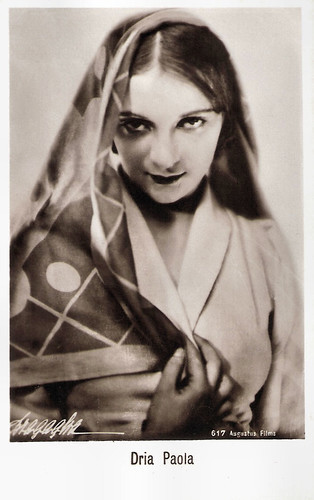
Italian postcard by G.B. Falci Editore, Milano, no. 617. Photo: Bragaglia / Augustus Films.
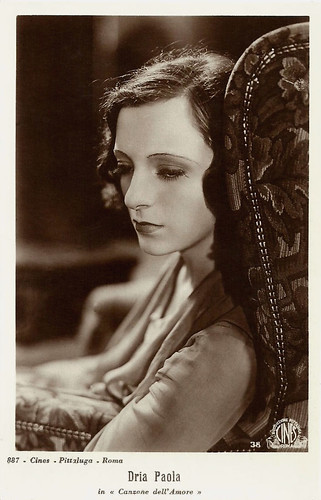
Italian postcard by Cines Pittaluga, Roma, no. 887. Photo: Cines, no. 38. Dria Paola in La canzone dell’amore/The song of love (Gennaro Righelli, 1930).
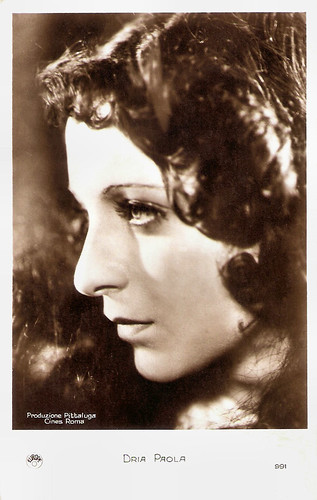
French postcard by Europe, no. 991. Photo: Produzione Pittaluga Cines, Roma.
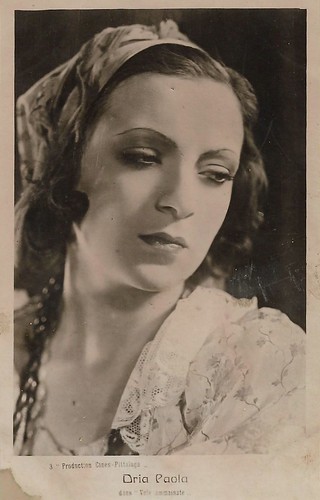
Italian postcard by Cines-Pittaluga, no. 3. Photo: Cines-Pittaluga. Dria Paola in Vele ammainate/Lowered Sails ( Anton Giulio Bragaglia, 1931).
Exotic and Mysterious
Dria Paola was born Pietra Giovanna Matilde Adele Pitteo in Rovigo, Italy in 1909, as the daughter of Arturo Pitteo, owner of hunting arms store and Ione Volebele, a cafe owner. Already at a young age, little Etra showed artistic temperament, dancing at the age of three and reciting when she was ten.
She initially worked for the company of Carlo Lombardo. After adopting the exotic and mysterious name of Dria Paola, she managed to get a small part as Neda in the late silent epic Gli ultimi giorni di Pompei/The Last Days of Pompeii (Carmine Gallone, Amleto Palermi, 1926) starring Victor Varconi , Rina De Liguoro, and Maria Corda .
A more substantial part Paola had in the late silent film Sole!/Sun! (1929), Alessandro Blasetti's debut as a film director, on the drainage and cultivation of the marshlands near Rome, the Agropontino. Unfortunately, less than a quarter of the film remains, while the Nazis destroyed the negative during the war.
Sole! wasn’t a public success, but Paola was more fortunate with her successive film, La canzone dell’amore/The song of love (Gennaro Righelli, 1930), the first Italian sound feature, entirely produced in Italy. The quite absurd story about a young woman who adopts the baby her mother gave birth to, was taken from a story by Luigi Pirandello, 'In silenzio' (In Silence).
While her mother dies giving birth, Lucia adopts little Ninni, pretending to her fiancé Enrico (Elio Steiner) and her landlady it is her own child. Lucia breaks up her engagement with Enrico, who is about to become a big musician. Lucia’s rival Anna, played by another upcoming star: Isa Pola , gets hold of Enrico. But when Lucia and Enrico meet again in the big record store where Lucia works and Enrico is making a record, he admits he still loves her. The father of the child ( Camillo Pilotto ) shows up and claims the child. Heartbroken, Lucia gives in but tries to commit suicide afterward. Just in time Enrico saves her, the father gives the child to Lucia and all is well.
The film opens and closes with images of Rome, and is actually one of the few Italian films from the 1930s showing the city repeatedly. Stylistically important are the different moments of double framing, when Lucia looks out from her rented rooms and mimics neighbours how to change diapers and feed the child. Interesting is also Righelli’s visualisation of Lucia’s frenzy at her suicide attempt and his pans across the enormous set of the record store.
La canzone dell’amore had its premiere on 7 October 1930 at the Supercinema in Rome (the actual Teatro Nazionale). The film was a popular success, not in the least because of the music composed by Cesare Andrea Bixio, whose well-known song 'Solo per te Lucia' became a hit as well. The film also caused two foreign remakes, one in German Liebeslied/Love Song (Constantin J. Davis, 1931) and one in French, La dernière berceuse/The last lullaby (Jean Cassagne, 1931).
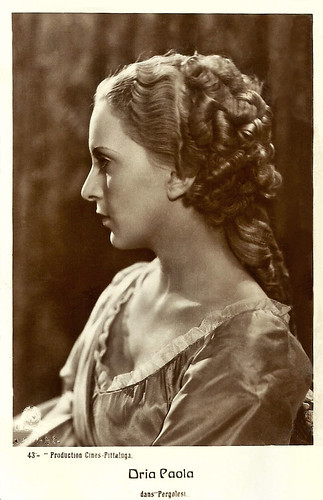
Italian postcard by G.B. Falci, Milano, no. 43. Photo: Cines-Pittaluga. Dria Paola as Maria in Pergolesi (Guido Brignone, 1932).
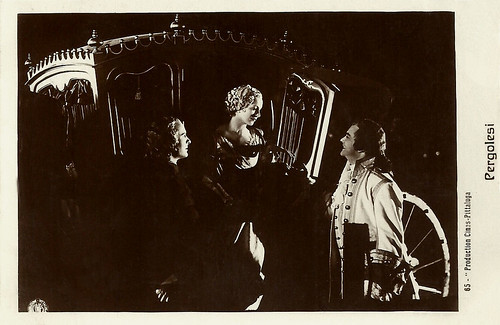
Italian postcard by G.B. Falci, Milano, no. 65. Photo: Cines-Pittaluga. Dria Paola as Maria in Pergolesi (Guido Brignone, 1932). The man left could be Elio Steiner as Pergolesi.
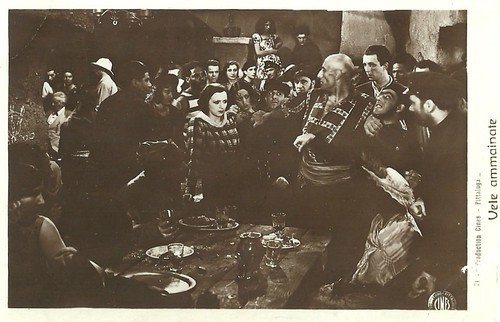
Italian postcard by Cines Pittaluga, no. 71. Photo: Cines-Pittaluga. Dria Paola in Vele ammainate/Lowered Sails (Anton Giulio Bragaglia, 1931).
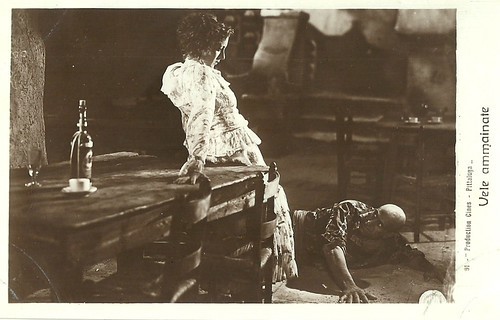
Italian postcard by Cines-Pattulaga, no. 91. Photo: Cines-Pattulaga. Dria Paola in Vele ammainate/Lowered Sails (Anton Giulio Bragaglia, 1931).
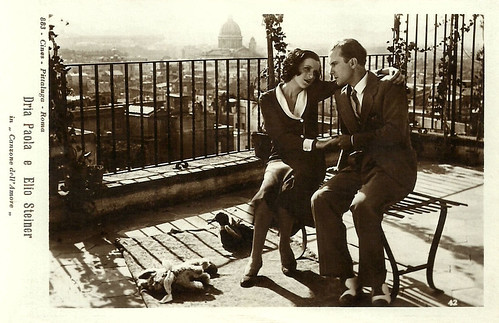
Italian postcard by G.B. Falci, Milano, no. 883. Photo: Cines-Pittaluga, Roma. After an attempted suicide, Lucia (Dria Paola) and Enrico (Elio Steiner) make up towards the end of La canzone dell’amore (Gennaro Righelli, 1930). The cityscape of Rome in the background.
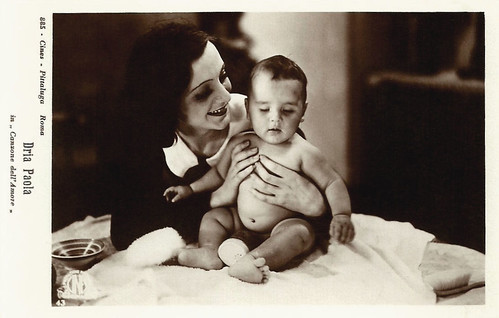
Italian postcard by G.B. Falci, Milano, no. 885. Photo: Cines Pittaluga, Roma. Dria Paola in La canzone dell’amore/The song of love (Gennaro Righelli, 1930).
Clumsy Damsel in Distress
Dria Paola was a star overnight. By now the thin actress with the big head and fluttering hands was typecasted as the fragile and sometimes clumsy damsel in distress. At the death of her father in 1932 she moved to Rome with her mother.
Her films included the avant-garde film Vele ammainate/Lowered sails (1931) - the only sound film by Anton Giulio Bragaglia, the biopic Pergolesi (Guido Brignone, 1932), and Fanny (Mario Almirante, 1933), based on Marcel Pagnol’s famous play, the sequel of his 'Marius'. While audiences liked Fanny, the press considered the film too stagey. The same happened with the original French adaptation, Fanny (Marc Allégret, 1932).
Then, Paola played a department store worker opposite a young Vittorio De Sica as a shoplifter in Il signore desidera?/Mr. Desire (Gennaro Righelli, 1933).
Her following leads were in La fanciulla dell’altro mondo/The girl from another world (Gennaro Righelli, 1934) and La cieca di Sorrento/The Blind Woman of Sorrento (Nunzio Malasomma, 1934), while she played supporting parts in Il colpo di vento/The blast (Carlo Felice Tavano, 1936) starring Ermete Zacconi, and L’albero di Adamo/Adam's Tree (Mario Bonnard, 1936) starring Elsa Merlini .
Righelli gave Paola a lead again in the Pirandello comedy Pensaci, Giacomino!/Think It Over Jack (Gennaro Righelli, 1936) starring Angelo Musco as a professor who marries his caretaker´s daughter, who is pregnant.
After supporting roles in the Raffaele Viviani drama L’ultimo scugnizzo/The last urchin (Gennaro Righelli, 1938), L’albergo degli assenti/The property of the absent (Raffaele Matarazzo, 1939), and Lotta nell’ombra/Fight in the shade (1939) by former acrobat turned director Domenico Gambino , Righelli provided another female lead for Paola in the historical drama Il cavaliere di San Marco/The Knight of San Marco (Gennaro Righelli, 1939), starring Mario Ferrari.
After a bit part in La grande luce/The great light (Carlo Campogalliani, 1939), Paola had a substantial part opposite Camillo Pilotto and Germana Paolieri in the naval spy story Traversata nera/Crossing the black (Domenico Gambino, 1939). Paola also had a major supporting part in Guido Brignone’s musical comedy La mia canzone al vento/My Song to the Wind (1939) with Laura Nucci and the female lead in La notte delle beffe/The Night of Tricks (Carlo Campogalliani, 1939), opposite Amedeo Nazzari .
Paola’s last parts were in the drama Cuori nella tormenta/Tormented Hearts (Carlo Campogalliani, 1940) and La pantera nera/The Black Panther (Domenico Gambino, 1942) starring Leda Gloria . Dria Paola then retired. Later she published her autobiography and did sporadic performances on stage and on television. One last film appearance was in the drama Cortile/Courtyard (Antonio Petrucci, 1955) starring Edoardo De Filippo .
In 1993, Dria Paola died completely forgotten in Rome, at the age of 83.
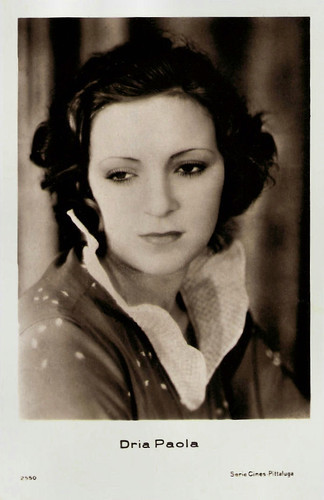
Italian postcard in the Series Cines Pittaluga by Casa Editrice Ballerini & Fratini, Firenze, no. 2550.
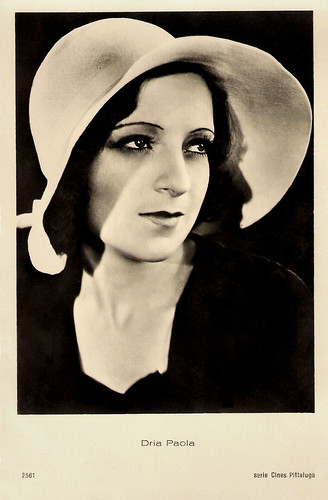
Italian postcard in the Series Cines Pittaluga by Casa Editrice Ballerini & Fratini, Firenze, no. 2561. Photo: Cines Pittaluga.
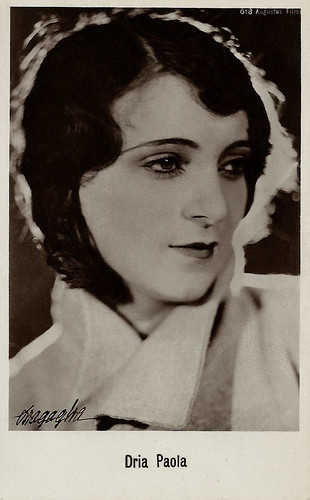
Italian postcard, no. 618. Photo Bragaglia / Augustus Film.
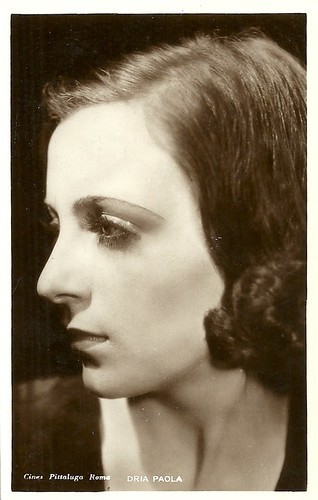
Italian postcard by Cines-Pittaluga, Rome.
Sources: Wikipedia (Italian and English), and .

Italian postcard by G.B. Falci Editore, Milano, no. 617. Photo: Bragaglia / Augustus Films.

Italian postcard by Cines Pittaluga, Roma, no. 887. Photo: Cines, no. 38. Dria Paola in La canzone dell’amore/The song of love (Gennaro Righelli, 1930).

French postcard by Europe, no. 991. Photo: Produzione Pittaluga Cines, Roma.

Italian postcard by Cines-Pittaluga, no. 3. Photo: Cines-Pittaluga. Dria Paola in Vele ammainate/Lowered Sails ( Anton Giulio Bragaglia, 1931).
Exotic and Mysterious
Dria Paola was born Pietra Giovanna Matilde Adele Pitteo in Rovigo, Italy in 1909, as the daughter of Arturo Pitteo, owner of hunting arms store and Ione Volebele, a cafe owner. Already at a young age, little Etra showed artistic temperament, dancing at the age of three and reciting when she was ten.
She initially worked for the company of Carlo Lombardo. After adopting the exotic and mysterious name of Dria Paola, she managed to get a small part as Neda in the late silent epic Gli ultimi giorni di Pompei/The Last Days of Pompeii (Carmine Gallone, Amleto Palermi, 1926) starring Victor Varconi , Rina De Liguoro, and Maria Corda .
A more substantial part Paola had in the late silent film Sole!/Sun! (1929), Alessandro Blasetti's debut as a film director, on the drainage and cultivation of the marshlands near Rome, the Agropontino. Unfortunately, less than a quarter of the film remains, while the Nazis destroyed the negative during the war.
Sole! wasn’t a public success, but Paola was more fortunate with her successive film, La canzone dell’amore/The song of love (Gennaro Righelli, 1930), the first Italian sound feature, entirely produced in Italy. The quite absurd story about a young woman who adopts the baby her mother gave birth to, was taken from a story by Luigi Pirandello, 'In silenzio' (In Silence).
While her mother dies giving birth, Lucia adopts little Ninni, pretending to her fiancé Enrico (Elio Steiner) and her landlady it is her own child. Lucia breaks up her engagement with Enrico, who is about to become a big musician. Lucia’s rival Anna, played by another upcoming star: Isa Pola , gets hold of Enrico. But when Lucia and Enrico meet again in the big record store where Lucia works and Enrico is making a record, he admits he still loves her. The father of the child ( Camillo Pilotto ) shows up and claims the child. Heartbroken, Lucia gives in but tries to commit suicide afterward. Just in time Enrico saves her, the father gives the child to Lucia and all is well.
The film opens and closes with images of Rome, and is actually one of the few Italian films from the 1930s showing the city repeatedly. Stylistically important are the different moments of double framing, when Lucia looks out from her rented rooms and mimics neighbours how to change diapers and feed the child. Interesting is also Righelli’s visualisation of Lucia’s frenzy at her suicide attempt and his pans across the enormous set of the record store.
La canzone dell’amore had its premiere on 7 October 1930 at the Supercinema in Rome (the actual Teatro Nazionale). The film was a popular success, not in the least because of the music composed by Cesare Andrea Bixio, whose well-known song 'Solo per te Lucia' became a hit as well. The film also caused two foreign remakes, one in German Liebeslied/Love Song (Constantin J. Davis, 1931) and one in French, La dernière berceuse/The last lullaby (Jean Cassagne, 1931).

Italian postcard by G.B. Falci, Milano, no. 43. Photo: Cines-Pittaluga. Dria Paola as Maria in Pergolesi (Guido Brignone, 1932).

Italian postcard by G.B. Falci, Milano, no. 65. Photo: Cines-Pittaluga. Dria Paola as Maria in Pergolesi (Guido Brignone, 1932). The man left could be Elio Steiner as Pergolesi.

Italian postcard by Cines Pittaluga, no. 71. Photo: Cines-Pittaluga. Dria Paola in Vele ammainate/Lowered Sails (Anton Giulio Bragaglia, 1931).

Italian postcard by Cines-Pattulaga, no. 91. Photo: Cines-Pattulaga. Dria Paola in Vele ammainate/Lowered Sails (Anton Giulio Bragaglia, 1931).

Italian postcard by G.B. Falci, Milano, no. 883. Photo: Cines-Pittaluga, Roma. After an attempted suicide, Lucia (Dria Paola) and Enrico (Elio Steiner) make up towards the end of La canzone dell’amore (Gennaro Righelli, 1930). The cityscape of Rome in the background.

Italian postcard by G.B. Falci, Milano, no. 885. Photo: Cines Pittaluga, Roma. Dria Paola in La canzone dell’amore/The song of love (Gennaro Righelli, 1930).
Clumsy Damsel in Distress
Dria Paola was a star overnight. By now the thin actress with the big head and fluttering hands was typecasted as the fragile and sometimes clumsy damsel in distress. At the death of her father in 1932 she moved to Rome with her mother.
Her films included the avant-garde film Vele ammainate/Lowered sails (1931) - the only sound film by Anton Giulio Bragaglia, the biopic Pergolesi (Guido Brignone, 1932), and Fanny (Mario Almirante, 1933), based on Marcel Pagnol’s famous play, the sequel of his 'Marius'. While audiences liked Fanny, the press considered the film too stagey. The same happened with the original French adaptation, Fanny (Marc Allégret, 1932).
Then, Paola played a department store worker opposite a young Vittorio De Sica as a shoplifter in Il signore desidera?/Mr. Desire (Gennaro Righelli, 1933).
Her following leads were in La fanciulla dell’altro mondo/The girl from another world (Gennaro Righelli, 1934) and La cieca di Sorrento/The Blind Woman of Sorrento (Nunzio Malasomma, 1934), while she played supporting parts in Il colpo di vento/The blast (Carlo Felice Tavano, 1936) starring Ermete Zacconi, and L’albero di Adamo/Adam's Tree (Mario Bonnard, 1936) starring Elsa Merlini .
Righelli gave Paola a lead again in the Pirandello comedy Pensaci, Giacomino!/Think It Over Jack (Gennaro Righelli, 1936) starring Angelo Musco as a professor who marries his caretaker´s daughter, who is pregnant.
After supporting roles in the Raffaele Viviani drama L’ultimo scugnizzo/The last urchin (Gennaro Righelli, 1938), L’albergo degli assenti/The property of the absent (Raffaele Matarazzo, 1939), and Lotta nell’ombra/Fight in the shade (1939) by former acrobat turned director Domenico Gambino , Righelli provided another female lead for Paola in the historical drama Il cavaliere di San Marco/The Knight of San Marco (Gennaro Righelli, 1939), starring Mario Ferrari.
After a bit part in La grande luce/The great light (Carlo Campogalliani, 1939), Paola had a substantial part opposite Camillo Pilotto and Germana Paolieri in the naval spy story Traversata nera/Crossing the black (Domenico Gambino, 1939). Paola also had a major supporting part in Guido Brignone’s musical comedy La mia canzone al vento/My Song to the Wind (1939) with Laura Nucci and the female lead in La notte delle beffe/The Night of Tricks (Carlo Campogalliani, 1939), opposite Amedeo Nazzari .
Paola’s last parts were in the drama Cuori nella tormenta/Tormented Hearts (Carlo Campogalliani, 1940) and La pantera nera/The Black Panther (Domenico Gambino, 1942) starring Leda Gloria . Dria Paola then retired. Later she published her autobiography and did sporadic performances on stage and on television. One last film appearance was in the drama Cortile/Courtyard (Antonio Petrucci, 1955) starring Edoardo De Filippo .
In 1993, Dria Paola died completely forgotten in Rome, at the age of 83.

Italian postcard in the Series Cines Pittaluga by Casa Editrice Ballerini & Fratini, Firenze, no. 2550.

Italian postcard in the Series Cines Pittaluga by Casa Editrice Ballerini & Fratini, Firenze, no. 2561. Photo: Cines Pittaluga.

Italian postcard, no. 618. Photo Bragaglia / Augustus Film.

Italian postcard by Cines-Pittaluga, Rome.
Sources: Wikipedia (Italian and English), and .
Published on April 23, 2020 22:00
April 22, 2020
Manfred Schnelldorfer
Former German Schlager singer and film actor Manfred Schnelldorfer (1943) started out as a figure skater, who became both World and Olympic champion in 1964.
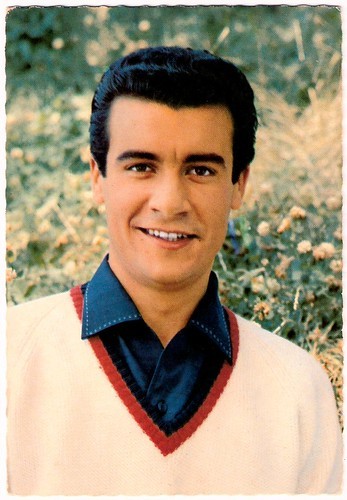
German postcard by ISV, no. K 31. Photo E. Schneider.
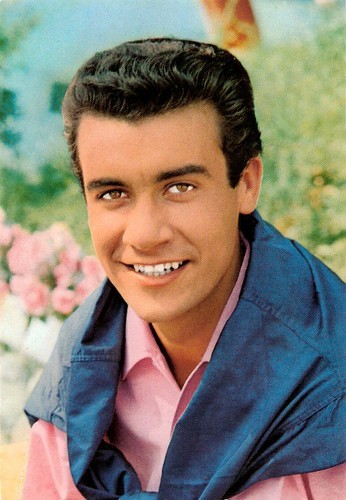
German postcard by ISV, no. K 38. Photo: E. Schneider.
Olympic champion
Manfred Schnelldorfer was born in München (Munich), Germany in 1943. He was the son of two figure skating coaches. His father had skated in an ice revue but saw its milieu as a harmful influence.
He won his first competition at the age of eight. He was coached by his parents and skated for the Munich ERC club.
At the German Junior Championships, Schnelldorfer finished second behind Hans-Jürgen Bäumler . The following year, he won the German senior title while Bäumler finished fourth. Internationally, he represented the Federal Republic of Germany (West Germany).
Manfred Schnelldorfer studied architecture at TH München (Technical University of Munich) but put his studies on hold for financial reasons. At age 20, he won the gold medal at the 1964 Winter Olympics in Innsbruck and became one of the youngest male figure skating Olympic champions. His victory was a surprise. The favourite was Alain Calmat of France, who won the Europeans between 1962 and 1964 and was silver medallist at the 1963 Worlds.
The Olympic Championship in 1964 was the highlight of his career. In all, Schnelldorfer was an eight-time German champion, one-time World champion (1964), three-time bronze and two-time silver medallist at the Europeans.
After his Olympic win, the Ice Capades offered Schnelldorfer a $1.5 million three-year contract but he declined because of a promise to his parents. For two years beginning in 1967, he served as the sports director, officially 'national coach', of the Deutsche Eislauf Union. After his parents gave their approval, he performed with the Deutsche Eistheater on Berlin from 1969 to 1973.
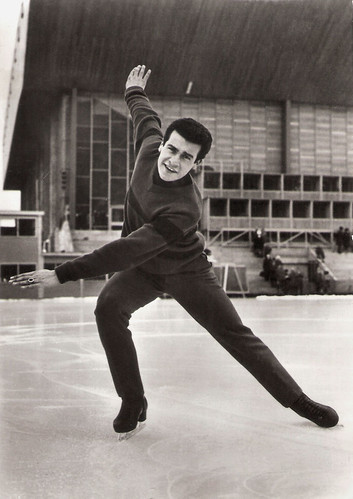
Czech postcard by Pressfoto, no S 12/11, 1964. Photo: Zdenek Havelka. Manfred Schnelldorfer becoming Olympic champion in 1964 in Innsbruck.
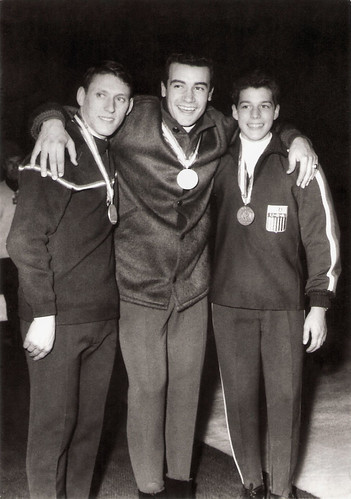
Czech postcard by Pressfoto, no S 12/12, 1964. Photo: Zdenek Havelka. Manfred Schnelldorfer becoming Olympic champion in 1964 at the IX Olympic Winter Games in Innsbruck. On the left, silver medallist Alain Calmat (France), and on the right, bronze medallist, Scott Allen (USA).
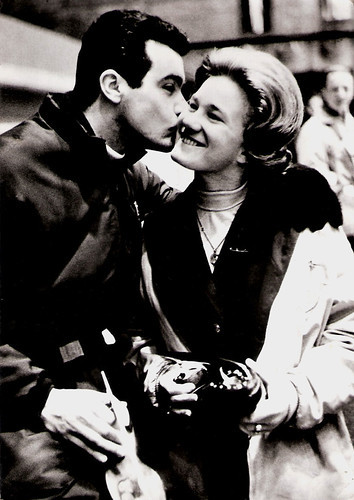
Dutch promotion card for Brio, no. BRI 434, 1964. Photo: Manfred Schnelldorfer kisses Dutch champion Sjoukje Dijkstra.
Schlagers
During the 1960s, Manfred Schnelldorfer also was a 'Schlagersänger' (pop singer) and film actor to finance his architecture studies. He had hits with such songs as 'Wenn du mal allein bist' (When you are once alone) and 'Deine schönen blauen Augen' (Your beautiful blue eyes).
He sang and acted ina half dozen light entertainment films. He made his film debut in Holiday in St. Tropez (Ernst Hofbauer, 1964) with Vivi Bach and Ann Smyrner.
His other films include Ich kauf' mir lieber einen Tirolerhut/I prefer to buy a Tiroler hat (Hans Billian, 1965) with Hannelore Auer and Gus Backus , Tausend Takte Übermut/Thousand takts high spirits (Ernst Hofbauer, 1965) with Vivi Bach and Rex Gildo , and Spukschloß im Salzkammergut/The Haunted Castle in Salzkammergut (Hans Billian, Rolf Olsen, 1966) with Udo Jürgens .
After that he became a coach and sports teacher. He was the first national coach of West Germany for figure skating (Eiskunstlauf-Bundestrainer) between 1974 and 1981.
Between 1981 and 1999 he owned his own sport shop and was a co-commentator for TV station Eurosport. Later he worked as a photographer.
Manfred Schnelldorfer lives in Munich. He is married and has two children. In 2018, he returned to the screen in an episode of the TV series Marie fängt Feuer/Marie is on Fire (2016-2019), starring Christine Eixenberger.
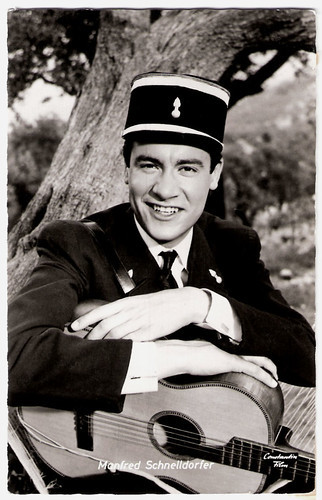
German postcard by Kolibri / Friedich-W. Sander-Verlag, Minden/Westf. no. 2200. Photo: Constantin Film. Manfred Schnelldorfer in Holiday in St. Tropez (Ernst Hofbauer, 1964).
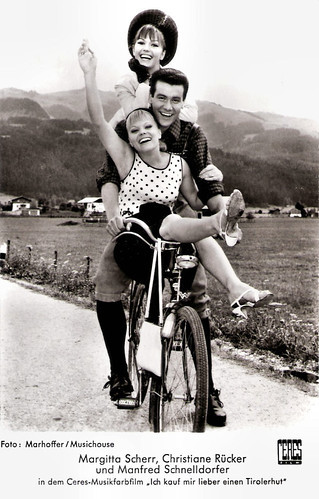
German postcard by Graphima, Berlin. Photo: Marhoffer / Musichouse / Ceres Film. Margitta Scherr, Christiane Rücker and Manfred Schnelldorfer in Ich kauf mir lieber einen Tirolerhut/I'd rather buy a Tyrolean hat (Hans Bilian, 1965).
Manfred Schnelldorfer sings 'Deine schönen blauen Augen' for Gus Backus in Ich kauf' mir lieber einen Tirolerhut/I prefer to buy a Tiroler hat (1965). Source: Fritz 5169 (YouTube).
Manfred Schnelldorfer sings his 1964 hit Wenn Du mal allein bist (If you're alone sometimes) in the TV show of Wim Thoelke (1965). Source: SportStudio (YouTube).
Sources: Wikipedia, and .

German postcard by ISV, no. K 31. Photo E. Schneider.

German postcard by ISV, no. K 38. Photo: E. Schneider.
Olympic champion
Manfred Schnelldorfer was born in München (Munich), Germany in 1943. He was the son of two figure skating coaches. His father had skated in an ice revue but saw its milieu as a harmful influence.
He won his first competition at the age of eight. He was coached by his parents and skated for the Munich ERC club.
At the German Junior Championships, Schnelldorfer finished second behind Hans-Jürgen Bäumler . The following year, he won the German senior title while Bäumler finished fourth. Internationally, he represented the Federal Republic of Germany (West Germany).
Manfred Schnelldorfer studied architecture at TH München (Technical University of Munich) but put his studies on hold for financial reasons. At age 20, he won the gold medal at the 1964 Winter Olympics in Innsbruck and became one of the youngest male figure skating Olympic champions. His victory was a surprise. The favourite was Alain Calmat of France, who won the Europeans between 1962 and 1964 and was silver medallist at the 1963 Worlds.
The Olympic Championship in 1964 was the highlight of his career. In all, Schnelldorfer was an eight-time German champion, one-time World champion (1964), three-time bronze and two-time silver medallist at the Europeans.
After his Olympic win, the Ice Capades offered Schnelldorfer a $1.5 million three-year contract but he declined because of a promise to his parents. For two years beginning in 1967, he served as the sports director, officially 'national coach', of the Deutsche Eislauf Union. After his parents gave their approval, he performed with the Deutsche Eistheater on Berlin from 1969 to 1973.

Czech postcard by Pressfoto, no S 12/11, 1964. Photo: Zdenek Havelka. Manfred Schnelldorfer becoming Olympic champion in 1964 in Innsbruck.

Czech postcard by Pressfoto, no S 12/12, 1964. Photo: Zdenek Havelka. Manfred Schnelldorfer becoming Olympic champion in 1964 at the IX Olympic Winter Games in Innsbruck. On the left, silver medallist Alain Calmat (France), and on the right, bronze medallist, Scott Allen (USA).

Dutch promotion card for Brio, no. BRI 434, 1964. Photo: Manfred Schnelldorfer kisses Dutch champion Sjoukje Dijkstra.
Schlagers
During the 1960s, Manfred Schnelldorfer also was a 'Schlagersänger' (pop singer) and film actor to finance his architecture studies. He had hits with such songs as 'Wenn du mal allein bist' (When you are once alone) and 'Deine schönen blauen Augen' (Your beautiful blue eyes).
He sang and acted ina half dozen light entertainment films. He made his film debut in Holiday in St. Tropez (Ernst Hofbauer, 1964) with Vivi Bach and Ann Smyrner.
His other films include Ich kauf' mir lieber einen Tirolerhut/I prefer to buy a Tiroler hat (Hans Billian, 1965) with Hannelore Auer and Gus Backus , Tausend Takte Übermut/Thousand takts high spirits (Ernst Hofbauer, 1965) with Vivi Bach and Rex Gildo , and Spukschloß im Salzkammergut/The Haunted Castle in Salzkammergut (Hans Billian, Rolf Olsen, 1966) with Udo Jürgens .
After that he became a coach and sports teacher. He was the first national coach of West Germany for figure skating (Eiskunstlauf-Bundestrainer) between 1974 and 1981.
Between 1981 and 1999 he owned his own sport shop and was a co-commentator for TV station Eurosport. Later he worked as a photographer.
Manfred Schnelldorfer lives in Munich. He is married and has two children. In 2018, he returned to the screen in an episode of the TV series Marie fängt Feuer/Marie is on Fire (2016-2019), starring Christine Eixenberger.

German postcard by Kolibri / Friedich-W. Sander-Verlag, Minden/Westf. no. 2200. Photo: Constantin Film. Manfred Schnelldorfer in Holiday in St. Tropez (Ernst Hofbauer, 1964).

German postcard by Graphima, Berlin. Photo: Marhoffer / Musichouse / Ceres Film. Margitta Scherr, Christiane Rücker and Manfred Schnelldorfer in Ich kauf mir lieber einen Tirolerhut/I'd rather buy a Tyrolean hat (Hans Bilian, 1965).
Manfred Schnelldorfer sings 'Deine schönen blauen Augen' for Gus Backus in Ich kauf' mir lieber einen Tirolerhut/I prefer to buy a Tiroler hat (1965). Source: Fritz 5169 (YouTube).
Manfred Schnelldorfer sings his 1964 hit Wenn Du mal allein bist (If you're alone sometimes) in the TV show of Wim Thoelke (1965). Source: SportStudio (YouTube).
Sources: Wikipedia, and .
Published on April 22, 2020 22:00
April 21, 2020
Antonio Gandusio
Antonio Gandusio (1873-1951) was one of the most famous comic actors of the twentieth-century theatre. He also had a rich career in the 1930s and 1940s Italian cinema. Gandusio appeared in 34 films between 1914 and 1948.
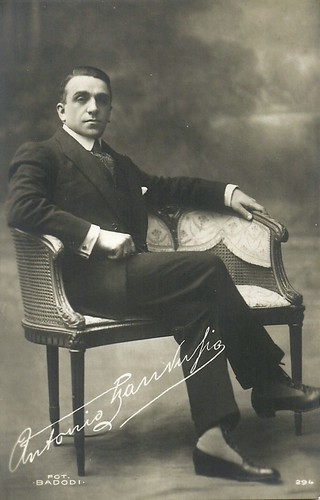
Italian postcard, no. 294. Photo: Badodi.
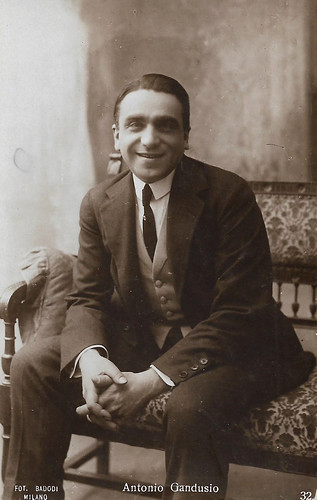
Italian postcard by Ed. A. Traldi, Milano, no. 32. Photo: Badodi, Milano.
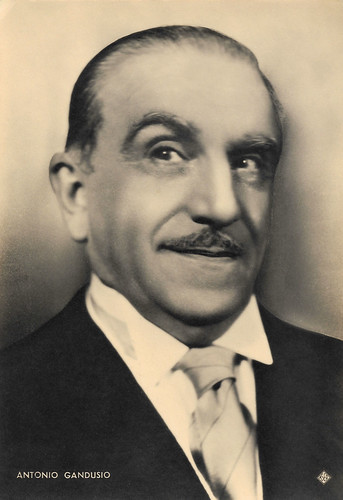
Italian postcard by ASER (A. Scarmiglia Edizioni Roma), no. 299. Photo: Vaselli / Lux Film. 1940s.
A graceless voice, a slight hump, and an irregular face
Antonio Gandusio was born in 1873 in Rovigno d'Istria, what was then still Austro-Hungarian Istria, now Rovin, Croatia. He went to law studies pushed by his father, a lawyer. He graduated studying first in Genoa and then in Rome, where he cultivated his passion for acting.
It prompted him to study at a theatre school and, subsequently, to find engagements at some of the most renowned theater companies of the time. In 1899 he obtained an engagement with Alfredo De Sanctis.
After that, he began long collaborations with the companies of Irma Gramatica , Flavio Andò, Evelina Paoli, Lyda Borelli , Ugo Piperno, Virgilio Talli, Maria Melato, and Annibale Betrone . He obtained the opportunity to work with actors of the caliber of Tina Di Lorenzo, Sergio Tofano and Uberto Palmarini.
His physical characteristics, a graceless voice, a slight hump, and an irregular face, made him suitable for the role of a comedian. In the wake of his family's tradition of 'Irredentismo', which had historically provided captains to the Republic of Venice, he refused to join their army after the outbreak of the First World War. Therefore, he was sentenced to death by the Austrian military court in 1915. He stayed in Italy and survived.
In 1918, he became the leader of a theatre company, staging a repertoire based mainly on 'pochades' and farces. Among the various productions, however, were also those of the plays by Luigi Pirandello, of which Gandusio was a sensitive interpreter. The managerial activity led him to become an interpreter of part of the new Italian dramaturgy represented by the work of Luigi Chiarelli and Luigi Pirandello. In his role as manager, he had the opportunity to direct actors such as Paolo Stoppa , Nico Pepe, and Nando Gazzolo.
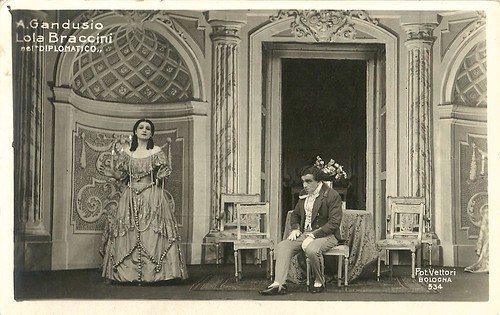
Italian postcard, no. 534. Photo: Vettori, Bologna. Lola Braccini and Antonio Gandusio in the play 'Il Diplomatico'.
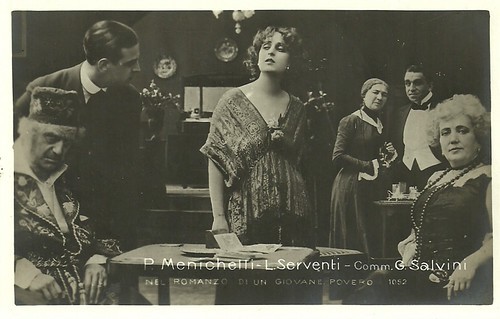
Italian postcard by Ed. Vettori Bologna, no. 1052. Pina Menichelli , Luigi Serventi, Gustavo Salvini and Antonio Gandusio in Il romanzo di un giovane povero/The Story of a Poor Young Man (Amleto Palermi, 1920), based on the novel 'Le Roman d'un jeune homme pauvre' (1858) by Octave Feuillet. The proud Margherita (Menichelli), daughter of the rich Laroque (Salvini), falls in love with her father's administrator, Massimo Odiot (Serventi), but fears he is only after her money. The real vulture, however, is a corrupt count (Gandusio), to whom Margharita is betrothed, unknowing of the man's plans. When Massimo and Margherita are accidentally locked into an old tower, and she treats him cruelly, Massimo sacrifices himself and jumps from the tower, to get help. When afterward he gets hold of a fortune, nothing can prevent the marriage between the two anymore.
Peaking in the late 1930s
In the silent era, Antonio Gandusio had three scarce, supporting roles in Rinunzia (Carmine Gallone, 1914) starring Soava Gallone , Strana (Alfredo Robert, 1917), and Il romanzo di un giovane povero/The Story of a Poor Young Man (Amleto Palermi, 1920) starring Pina Menichelli , and Luigi Serventi .
From the early 1930s, Gandusio's film acting career really set off when sound had set in. He peaked in the later 1930s with such films as L'albero di Adamo/Adam's Tree (Mario Bonnard, 1938) based on a play by Alfredo Testoni, the comedy Per uomini soli/For Men Only (Guido Brignone, 1938), the romantic comedy Eravamo 7 sorelle/We Were Seven Sisters (Nunzio Malasomma, 1939), Eravamo sette vedove/We Were Seven Widows (Mario Mattoli, 1939), and the comedy Frenesia/Frenzy (Mario Bonnard, 1939) with Dina Galli .
In all these films, Gandusio played the lead or at least the male lead opposite such actresses as Elsa Merlini and Betty Stockfeld. Or he was the second man of films like Cose dell'altro mondo (Nunzio Malasomma, 1939). During the war years, Gandusio film career remained high with his leads in Manovre d'amore/Maneuvers of love (Gennaro Righelli, 1940), Se non son matti non li vogliamo/If they are not crazy, we don't want them (Esodo Pratelli, 1941), and Le signorine della villa accanto/The ladies of the villa next door (Gian Paolo Rosmino, 1942).
Well-known films of the 1940s in which Gandusio had major parts were Stasera niente di nuovo/Nothing new tonight (Mario Mattoli, 1942) with Alida Valli , and La vispa Teresa/Lively Teresa (Mario Mattoli, 1943) with Lilia Silvi .
After the war, Gandusio still acted in a handful of films, including the drama Lo sconosciuto di San Marino/The Unknown Man of San Marino (Michał Waszyński, 1948) with Vittorio De Sica . He stopped acting after 1948.
Antonio Gandusio passed away in 1951 in Milan. He was 75. In his hometown, the city theatre took his name.
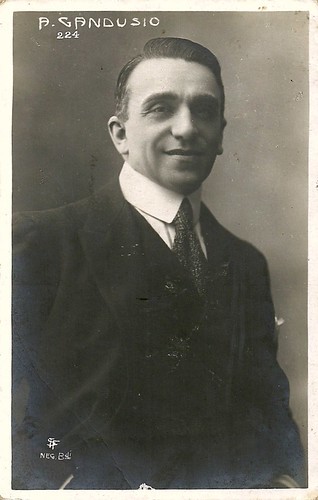
Italian postcard by SIF. Photo: Badodi.
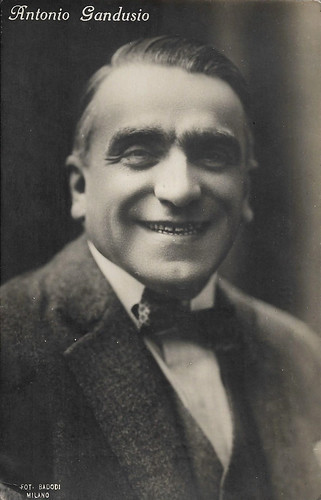
Italian postcard. Photo: Badodi, Milano. Antonio Gandusio in the play 'Baciatemi' by Bernard, Mirande and Quinson, Teatro Goldoni, 9 May 1927, "Serata in Onore di Antonio Gandusio". Other actors in the play were a.o. Giacomo Almirante, Olinto Cristina, Enrico Viarisio and Lola Braccini, all of whom had subsequent film careers in the 1930s and 1940s.
Sources: Wikipedia (Italian and English), and .

Italian postcard, no. 294. Photo: Badodi.

Italian postcard by Ed. A. Traldi, Milano, no. 32. Photo: Badodi, Milano.

Italian postcard by ASER (A. Scarmiglia Edizioni Roma), no. 299. Photo: Vaselli / Lux Film. 1940s.
A graceless voice, a slight hump, and an irregular face
Antonio Gandusio was born in 1873 in Rovigno d'Istria, what was then still Austro-Hungarian Istria, now Rovin, Croatia. He went to law studies pushed by his father, a lawyer. He graduated studying first in Genoa and then in Rome, where he cultivated his passion for acting.
It prompted him to study at a theatre school and, subsequently, to find engagements at some of the most renowned theater companies of the time. In 1899 he obtained an engagement with Alfredo De Sanctis.
After that, he began long collaborations with the companies of Irma Gramatica , Flavio Andò, Evelina Paoli, Lyda Borelli , Ugo Piperno, Virgilio Talli, Maria Melato, and Annibale Betrone . He obtained the opportunity to work with actors of the caliber of Tina Di Lorenzo, Sergio Tofano and Uberto Palmarini.
His physical characteristics, a graceless voice, a slight hump, and an irregular face, made him suitable for the role of a comedian. In the wake of his family's tradition of 'Irredentismo', which had historically provided captains to the Republic of Venice, he refused to join their army after the outbreak of the First World War. Therefore, he was sentenced to death by the Austrian military court in 1915. He stayed in Italy and survived.
In 1918, he became the leader of a theatre company, staging a repertoire based mainly on 'pochades' and farces. Among the various productions, however, were also those of the plays by Luigi Pirandello, of which Gandusio was a sensitive interpreter. The managerial activity led him to become an interpreter of part of the new Italian dramaturgy represented by the work of Luigi Chiarelli and Luigi Pirandello. In his role as manager, he had the opportunity to direct actors such as Paolo Stoppa , Nico Pepe, and Nando Gazzolo.

Italian postcard, no. 534. Photo: Vettori, Bologna. Lola Braccini and Antonio Gandusio in the play 'Il Diplomatico'.

Italian postcard by Ed. Vettori Bologna, no. 1052. Pina Menichelli , Luigi Serventi, Gustavo Salvini and Antonio Gandusio in Il romanzo di un giovane povero/The Story of a Poor Young Man (Amleto Palermi, 1920), based on the novel 'Le Roman d'un jeune homme pauvre' (1858) by Octave Feuillet. The proud Margherita (Menichelli), daughter of the rich Laroque (Salvini), falls in love with her father's administrator, Massimo Odiot (Serventi), but fears he is only after her money. The real vulture, however, is a corrupt count (Gandusio), to whom Margharita is betrothed, unknowing of the man's plans. When Massimo and Margherita are accidentally locked into an old tower, and she treats him cruelly, Massimo sacrifices himself and jumps from the tower, to get help. When afterward he gets hold of a fortune, nothing can prevent the marriage between the two anymore.
Peaking in the late 1930s
In the silent era, Antonio Gandusio had three scarce, supporting roles in Rinunzia (Carmine Gallone, 1914) starring Soava Gallone , Strana (Alfredo Robert, 1917), and Il romanzo di un giovane povero/The Story of a Poor Young Man (Amleto Palermi, 1920) starring Pina Menichelli , and Luigi Serventi .
From the early 1930s, Gandusio's film acting career really set off when sound had set in. He peaked in the later 1930s with such films as L'albero di Adamo/Adam's Tree (Mario Bonnard, 1938) based on a play by Alfredo Testoni, the comedy Per uomini soli/For Men Only (Guido Brignone, 1938), the romantic comedy Eravamo 7 sorelle/We Were Seven Sisters (Nunzio Malasomma, 1939), Eravamo sette vedove/We Were Seven Widows (Mario Mattoli, 1939), and the comedy Frenesia/Frenzy (Mario Bonnard, 1939) with Dina Galli .
In all these films, Gandusio played the lead or at least the male lead opposite such actresses as Elsa Merlini and Betty Stockfeld. Or he was the second man of films like Cose dell'altro mondo (Nunzio Malasomma, 1939). During the war years, Gandusio film career remained high with his leads in Manovre d'amore/Maneuvers of love (Gennaro Righelli, 1940), Se non son matti non li vogliamo/If they are not crazy, we don't want them (Esodo Pratelli, 1941), and Le signorine della villa accanto/The ladies of the villa next door (Gian Paolo Rosmino, 1942).
Well-known films of the 1940s in which Gandusio had major parts were Stasera niente di nuovo/Nothing new tonight (Mario Mattoli, 1942) with Alida Valli , and La vispa Teresa/Lively Teresa (Mario Mattoli, 1943) with Lilia Silvi .
After the war, Gandusio still acted in a handful of films, including the drama Lo sconosciuto di San Marino/The Unknown Man of San Marino (Michał Waszyński, 1948) with Vittorio De Sica . He stopped acting after 1948.
Antonio Gandusio passed away in 1951 in Milan. He was 75. In his hometown, the city theatre took his name.

Italian postcard by SIF. Photo: Badodi.

Italian postcard. Photo: Badodi, Milano. Antonio Gandusio in the play 'Baciatemi' by Bernard, Mirande and Quinson, Teatro Goldoni, 9 May 1927, "Serata in Onore di Antonio Gandusio". Other actors in the play were a.o. Giacomo Almirante, Olinto Cristina, Enrico Viarisio and Lola Braccini, all of whom had subsequent film careers in the 1930s and 1940s.
Sources: Wikipedia (Italian and English), and .
Published on April 21, 2020 22:00
April 20, 2020
Abschied (1968)
Abschied/Farewell (Egon Günther, 1968) has a typical sixties subject: the alienation of young people. Unusual is that the film was made in East-Germany. But typical for this Communist state was that the film was unofficially banned. The fresh and good looking stars of this little gem were Jan Spitzer and Heidemarie Wenzel.
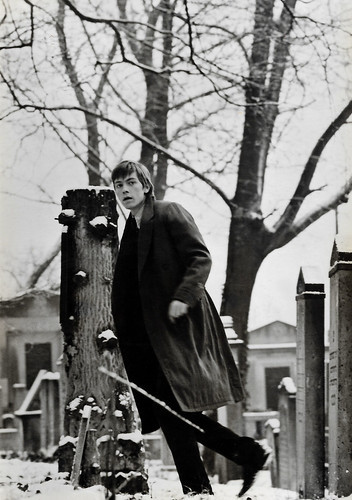
East-German postcard by VEB Progress Film-Vertrieb, Berlin, no. 3278, 1968. Photo: DEFA / Dietrich. Jan Spitzer in Abschied/Farewell (Egon Günther, 1968).
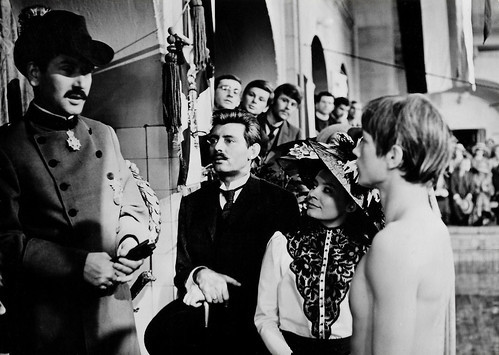
East-German postcard by VEB Progress Film-Vertrieb, Berlin, no. 3279, 1968. Photo: DEFA / Dietrich. Rolf Ludwig, Katharina Lind and Jan Spitzer in Abschied/Farewell (Egon Günther, 1968).
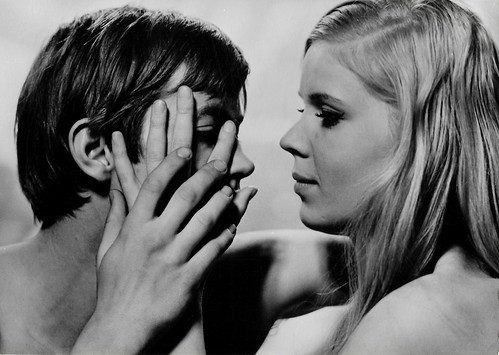
East-German postcard by VEB Progress Film-Vertrieb, Berlin, no. 3281, 1968. Photo: DEFA / Dietrich. Jan Spitzer and Heidemarie Wenzel in Abschied/Farewell (Egon Günther, 1968).
A farewell to his class
During the 1960s, many films in Hollywood and Europe were made about alienated young men. Abschied/Farewell (Egon Günther, 1968) is another film in that genre, but this one has the distinction of being made in East Germany, a country where you would not imagine a film celebrating non-conformity could be made.
The film was based on 'Abschied' a famous German novel by Johannes R. Becher and SED politician Alexander Abusch contributed to the scenario in an advisory capacity. Also, the society the lead character is rebelling about is Germany in the years leading up to the first World War. This explains how the unconventional film could be made.
In August 1914, amidst the public ecstasy surrounding the impending war, Hans Gastl ( Jan Spitzer ) is the seventeen year-old son of a prominent prosecutor (Rolf Ludwig) in Munich. The bullying and hypocrisy of his father and the other adults around him sicken him and he drifts into a life of petty crime. Will some new found friends save him from the road to ruin with their talk of socialism and Karl Marx?
He seeks refuge with Fanny ( Heidemarie Wenzel ), a prostitute who still has the strength for real feelings, but not the strength to break away from her milieu. Gastl finds new friends among artists. But the war turns some of them - once expressive opponents of the war - into fanatical war supporters. The artist Sack, a poet, remains his only companion.
Hans makes a decision: he will not take part in this war. This resolution signifies a turning point in his life; a farewell to his class and his family. His notions of 'transformation' are still nebulous, but are nevertheless linked with a sensible life in a just society.
Abschied/Farewell (Egon Günther, 1968) is a visually striking film, with many shots and editing tricks that owe a debt to the French New Wave films of the 1960s. The film has an anachronistic look. Despite being set in the 1910s, everyone looks like they just stepped out of a 1960s fashion magazine. Director Egon Günther did not want to make a mere literary adaptation but translated it to the current GDR.
The film premiere was on 10 October 1968 in Berlin. Abschied was awarded the title 'Particularly valuable', but soon it was criticised for its "stylistic devices". Egon Günther and Günter Kunert had implemented the novel “as a modern satirical spectacle, anti-bourgeois and pacifist at the same time”. At the 9th plenary session of the Central Committee of the SED on 24 October 1968, the film was sharply criticised. When the film was to be shown at a ceremony in honour of Johannes R. Becher, Walter Ulbricht demonstratively left the cinema shortly before the start of the performance.
Abschied was taken from the East-German cinemas after a short time and later only ran occasionally in individual screenings. While the film never ran on television in the GDR, the ZDF showed him the film 1971 on West-German television. In 2007 the film was released on DVD by Icestorm.
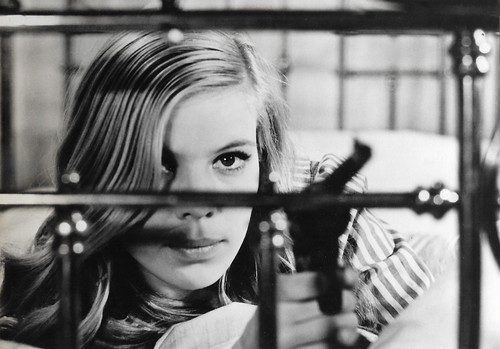
East-German postcard by VEB Progress Film-Vertrieb, Berlin, no. 3282, 1968. Photo: DEFA / Dietrich. Jan Spitzer and Heidemarie Wenzel in Abschied/Farewell (Egon Günther, 1968).
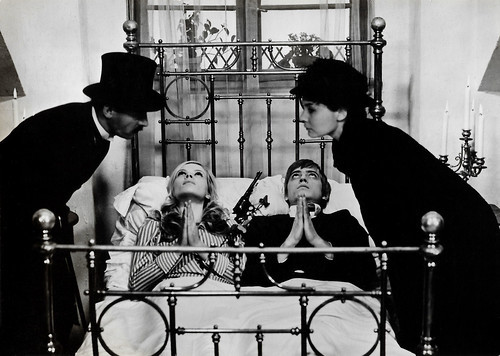
East-German postcard by VEB Progress Film-Vertrieb, Berlin, no. 3283, 1968. Photo: DEFA / Dietrich. Jan Spitzer and Heidemarie Wenzel in Abschied/Farewell (Egon Günther, 1968).
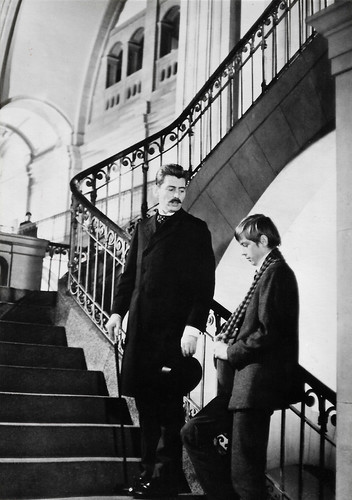
East-German card by VEB Progress Film-Vertrieb, Berlin, no. 3284, 1968. Photo: DEFA / Dietrich. Rolf Ludwig and Jan Spitzer in Abschied/Farewell (Egon Günther, 1968).
Sources: Filmportal.de (German), Wikipedia (German) and IMDb.

East-German postcard by VEB Progress Film-Vertrieb, Berlin, no. 3278, 1968. Photo: DEFA / Dietrich. Jan Spitzer in Abschied/Farewell (Egon Günther, 1968).

East-German postcard by VEB Progress Film-Vertrieb, Berlin, no. 3279, 1968. Photo: DEFA / Dietrich. Rolf Ludwig, Katharina Lind and Jan Spitzer in Abschied/Farewell (Egon Günther, 1968).

East-German postcard by VEB Progress Film-Vertrieb, Berlin, no. 3281, 1968. Photo: DEFA / Dietrich. Jan Spitzer and Heidemarie Wenzel in Abschied/Farewell (Egon Günther, 1968).
A farewell to his class
During the 1960s, many films in Hollywood and Europe were made about alienated young men. Abschied/Farewell (Egon Günther, 1968) is another film in that genre, but this one has the distinction of being made in East Germany, a country where you would not imagine a film celebrating non-conformity could be made.
The film was based on 'Abschied' a famous German novel by Johannes R. Becher and SED politician Alexander Abusch contributed to the scenario in an advisory capacity. Also, the society the lead character is rebelling about is Germany in the years leading up to the first World War. This explains how the unconventional film could be made.
In August 1914, amidst the public ecstasy surrounding the impending war, Hans Gastl ( Jan Spitzer ) is the seventeen year-old son of a prominent prosecutor (Rolf Ludwig) in Munich. The bullying and hypocrisy of his father and the other adults around him sicken him and he drifts into a life of petty crime. Will some new found friends save him from the road to ruin with their talk of socialism and Karl Marx?
He seeks refuge with Fanny ( Heidemarie Wenzel ), a prostitute who still has the strength for real feelings, but not the strength to break away from her milieu. Gastl finds new friends among artists. But the war turns some of them - once expressive opponents of the war - into fanatical war supporters. The artist Sack, a poet, remains his only companion.
Hans makes a decision: he will not take part in this war. This resolution signifies a turning point in his life; a farewell to his class and his family. His notions of 'transformation' are still nebulous, but are nevertheless linked with a sensible life in a just society.
Abschied/Farewell (Egon Günther, 1968) is a visually striking film, with many shots and editing tricks that owe a debt to the French New Wave films of the 1960s. The film has an anachronistic look. Despite being set in the 1910s, everyone looks like they just stepped out of a 1960s fashion magazine. Director Egon Günther did not want to make a mere literary adaptation but translated it to the current GDR.
The film premiere was on 10 October 1968 in Berlin. Abschied was awarded the title 'Particularly valuable', but soon it was criticised for its "stylistic devices". Egon Günther and Günter Kunert had implemented the novel “as a modern satirical spectacle, anti-bourgeois and pacifist at the same time”. At the 9th plenary session of the Central Committee of the SED on 24 October 1968, the film was sharply criticised. When the film was to be shown at a ceremony in honour of Johannes R. Becher, Walter Ulbricht demonstratively left the cinema shortly before the start of the performance.
Abschied was taken from the East-German cinemas after a short time and later only ran occasionally in individual screenings. While the film never ran on television in the GDR, the ZDF showed him the film 1971 on West-German television. In 2007 the film was released on DVD by Icestorm.

East-German postcard by VEB Progress Film-Vertrieb, Berlin, no. 3282, 1968. Photo: DEFA / Dietrich. Jan Spitzer and Heidemarie Wenzel in Abschied/Farewell (Egon Günther, 1968).

East-German postcard by VEB Progress Film-Vertrieb, Berlin, no. 3283, 1968. Photo: DEFA / Dietrich. Jan Spitzer and Heidemarie Wenzel in Abschied/Farewell (Egon Günther, 1968).

East-German card by VEB Progress Film-Vertrieb, Berlin, no. 3284, 1968. Photo: DEFA / Dietrich. Rolf Ludwig and Jan Spitzer in Abschied/Farewell (Egon Günther, 1968).
Sources: Filmportal.de (German), Wikipedia (German) and IMDb.
Published on April 20, 2020 22:00
April 19, 2020
Rolf Herricht
Rolf Herricht (1927-1981) was one of East Germany's most celebrated comedians. He starred in several popular DEFA comedies during the 1960s and the 1970s.
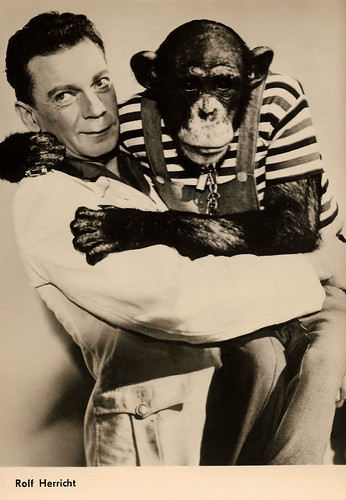
East-German postcard by VEB Progress Filmvertrieb, Berlin, no. 2041, 1964. Photo: Herbert Kroiss / DEFA. Rolf Herricht with chimpanzee in Geliebte Weiße Maus/Beloved White Mouse (Gottfried Kolditz, 1964).
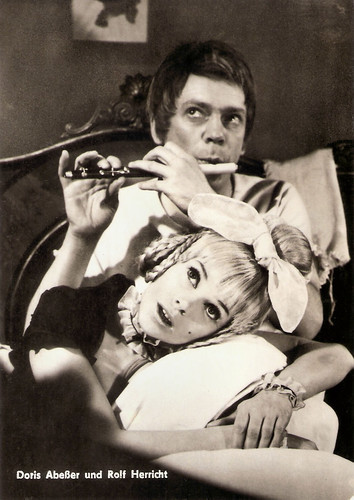
East-German postcard by VEB Progress Filmvertrieb, Berlin, no. 3335, 1969. Photo: DEFA / Wenzel. Doris Abesser and Rolf Herricht in Hauptmann Florian von der Mühle/Captain Florian of the Mill (Werner W. Wallroth, 1968).
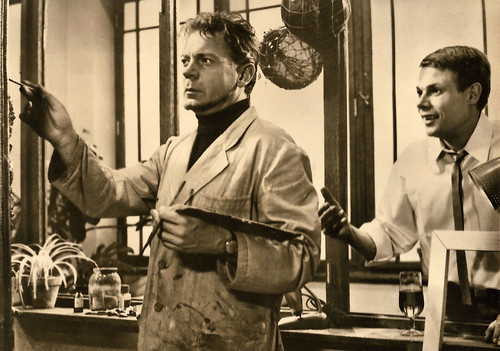
East-German postcard by VEB Progress Film-Vertrieb, Berlin, no. 106e. Photo: DEFA / Pathenheimer. Rolf Herricht and Klaus Piontek in Seine Hoheit - Genosse Prinz/His Highness - Comrade Prince (Werner W. Wallroth, 1969).
The naïve, funny man
Rolf Oskar Ewald Günter Herricht was born in Magdeburg, Germany, in 1927.
He graduated from school in 1943 after passing a 'War Abitur', a form of an Abitur designated to free school pupils to be mobilised. In 1945, he was drafted to the Volkssturm and assigned as an anti-aircraft battery assistant.
After the war's end, the 18-years-old began working as a property master and stage manager in a theatre in his native Magdeburg, while studying acting in a local studio. After completion, he went to appear on the stages of theatres in Salzwedel, Stendal, Staßfurt, Güstrow and also in the Kleist Theater in Frankfurt am Oder.
Herricht first met fellow actor Hans-Joachim Preil in 1951, while they both worked in Bernburg. The two formed the 'Herricht and Preil' comedy duo, staging their first sketch, 'The Chess Match', in 1953. In the sketch, Preil vainly attempts to play chess with Herricht, who is completely oblivious to the rules of the game. In their act, Herricht played the naïve 'funny man', while Preil served as the instructing 'straight man'. Preil wrote the sketches and the two were active until Herricht's passing away in 1981.
In 1957, Herricht returned to the Magdeburg Theater, where he remained until 1961. He mainly played comical characters, like the scribe in 'The Beaver Coat' and the drunkard from Auerbach's Cellar in 'Faust I'. During his time in Magdeburg, he also worked on the radio.
He and Preil first performed on television when one of their sketches was broadcast by Deutscher Fernsehfunk in 1959. The show was well received by the audience and the two began making regular appearances on TV. Herricht and Preil became the German Democratic Republic's most celebrated comedians.
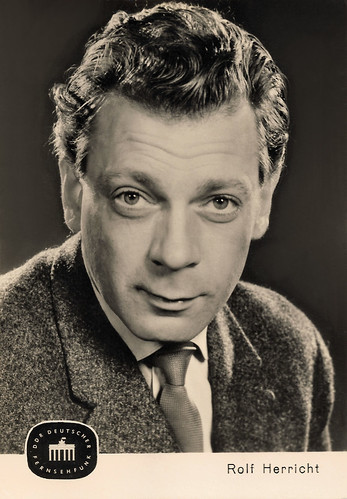
East-German postcard by VEB Bild und Heimat Reichenbach I.V., no. G 6104, 1964. Photo: Denger / Deutscher Fernsehfunk DDR, 1962.
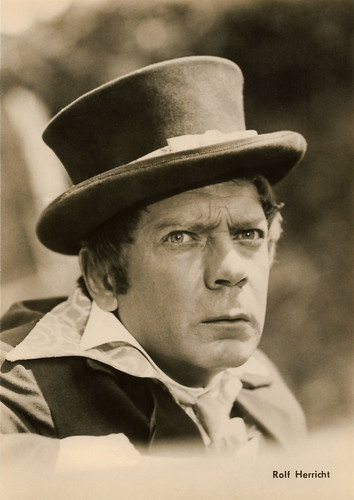
East-German postcard by VEB Progress Filmvertrieb, Berlin, no. 3317, 1969. Photo: DEFA / Wenzel. Rolf Herricht in Hauptmann Florian von der Mühle/Captain Florian of the Mill (Werner W. Wallroth, 1968).
Banned by the Socialist Unity Party
Rolf Herricht made his film debut in DEFA's comedy Bevor der Blitz einschlägt/Before the Lightning Strikes (Richard Groschopp, 1959), playing a minor part of a locomotive constructor. The same year, he starred in the romantic comedy Musterknaben/The Goodies (Johannes Knittel, 1959) with Hartmut Reck and Brigitte Krause.
Herricht later appeared in some twenty feature films, while also playing in many television films. In 1964, he joined the regular cast of the Metropol Theater in Berlin. He also had a career as a singer.
Herricht appeared on screen in relatively minor roles until writer Maurycy Janowski and director Gottfried Kolditz decided to create a film the plot of which would be based on his comical skill, the musical Geliebte weiße Maus/Beloved White Mouse (Gottfried Kolditz, 1964). Herricht portrayed a traffic policeman who falls in love with a woman and only dares speak to her when she makes an accident on the road. The picture met with considerable success.
Herricht starred in several other popular DEFA comedies during the 1960s and the 1970s: among others, he played the erratic National People's Army reserve soldier Ralf Horricht in Der Reserveheld/The reserve hero (Wolfgang Luderer, 1965) and the last-minute-travel-guide Hurtig in Meine Freundin Sybille/My Friend Sybille (Wolfgang Luderer, 1967) with Evelyn Opoczynski.
His crime comedy Hände hoch oder ich schieße/Hands Up or I'll Shoot (Hans-Joachim Kasprzik, 1965), in which he again appeared as the eccentric policeman officer Holms, was banned at the 11th plenary session of the Socialist Unity Party of Germany.
His later films included Seine Hoheit - Genosse Prinz/His Highness - Comrade Prince (Werner W. Wallroth, 1969) with Rolf Ludwig, Husaren in Berlin/Hussars in Berlin (Erwin Stranka, 1971) with Manfred Krug , and Der Mann, der nach der Oma kam/The man who came after Grandma (Roland Oehme, 1972), also starring Ilse Voigt. Herricht was twice awarded the Kunstpreis der Deutschen Demokratischen Republik (Art Prize of the German Democratic Republic): in 1973 and in 1977.
Rolf Herricht, a chain smoker, died of a heart attack at the age of 53, while performing the role of one of the gangsters in 'Kiss Me, Kate' on the stage of the Metropol. He is buried in Berlin's I Französischer Friedhof. He was married to Christa Herricht. They had one child, daughter Dana.
28 years after Herricht's death, the banned film Hände hoch oder ich schieße/Hands Up or I'll Shoot was finally completed and distributed in 2009, making it the last East German film to be released.
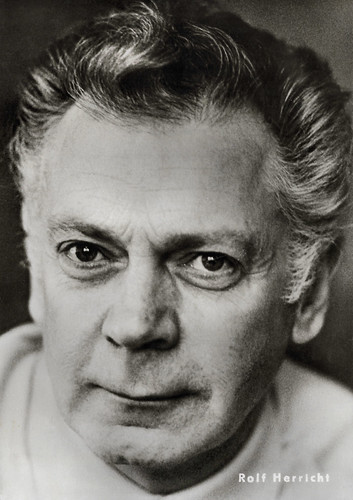
East-German postcard by VEB Progress Film-Verleih, Berlin, no. 56/77, 1977. Photo: Uhlenhut.
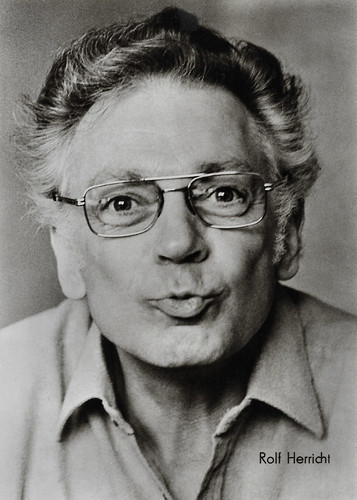
East-German postcard by VEB Progress Film-Verleih, Berlin, no. 30/80, 1979. Photo: Peter Söllner.
Sources: Wikipedia (German and English) and .

East-German postcard by VEB Progress Filmvertrieb, Berlin, no. 2041, 1964. Photo: Herbert Kroiss / DEFA. Rolf Herricht with chimpanzee in Geliebte Weiße Maus/Beloved White Mouse (Gottfried Kolditz, 1964).

East-German postcard by VEB Progress Filmvertrieb, Berlin, no. 3335, 1969. Photo: DEFA / Wenzel. Doris Abesser and Rolf Herricht in Hauptmann Florian von der Mühle/Captain Florian of the Mill (Werner W. Wallroth, 1968).

East-German postcard by VEB Progress Film-Vertrieb, Berlin, no. 106e. Photo: DEFA / Pathenheimer. Rolf Herricht and Klaus Piontek in Seine Hoheit - Genosse Prinz/His Highness - Comrade Prince (Werner W. Wallroth, 1969).
The naïve, funny man
Rolf Oskar Ewald Günter Herricht was born in Magdeburg, Germany, in 1927.
He graduated from school in 1943 after passing a 'War Abitur', a form of an Abitur designated to free school pupils to be mobilised. In 1945, he was drafted to the Volkssturm and assigned as an anti-aircraft battery assistant.
After the war's end, the 18-years-old began working as a property master and stage manager in a theatre in his native Magdeburg, while studying acting in a local studio. After completion, he went to appear on the stages of theatres in Salzwedel, Stendal, Staßfurt, Güstrow and also in the Kleist Theater in Frankfurt am Oder.
Herricht first met fellow actor Hans-Joachim Preil in 1951, while they both worked in Bernburg. The two formed the 'Herricht and Preil' comedy duo, staging their first sketch, 'The Chess Match', in 1953. In the sketch, Preil vainly attempts to play chess with Herricht, who is completely oblivious to the rules of the game. In their act, Herricht played the naïve 'funny man', while Preil served as the instructing 'straight man'. Preil wrote the sketches and the two were active until Herricht's passing away in 1981.
In 1957, Herricht returned to the Magdeburg Theater, where he remained until 1961. He mainly played comical characters, like the scribe in 'The Beaver Coat' and the drunkard from Auerbach's Cellar in 'Faust I'. During his time in Magdeburg, he also worked on the radio.
He and Preil first performed on television when one of their sketches was broadcast by Deutscher Fernsehfunk in 1959. The show was well received by the audience and the two began making regular appearances on TV. Herricht and Preil became the German Democratic Republic's most celebrated comedians.

East-German postcard by VEB Bild und Heimat Reichenbach I.V., no. G 6104, 1964. Photo: Denger / Deutscher Fernsehfunk DDR, 1962.

East-German postcard by VEB Progress Filmvertrieb, Berlin, no. 3317, 1969. Photo: DEFA / Wenzel. Rolf Herricht in Hauptmann Florian von der Mühle/Captain Florian of the Mill (Werner W. Wallroth, 1968).
Banned by the Socialist Unity Party
Rolf Herricht made his film debut in DEFA's comedy Bevor der Blitz einschlägt/Before the Lightning Strikes (Richard Groschopp, 1959), playing a minor part of a locomotive constructor. The same year, he starred in the romantic comedy Musterknaben/The Goodies (Johannes Knittel, 1959) with Hartmut Reck and Brigitte Krause.
Herricht later appeared in some twenty feature films, while also playing in many television films. In 1964, he joined the regular cast of the Metropol Theater in Berlin. He also had a career as a singer.
Herricht appeared on screen in relatively minor roles until writer Maurycy Janowski and director Gottfried Kolditz decided to create a film the plot of which would be based on his comical skill, the musical Geliebte weiße Maus/Beloved White Mouse (Gottfried Kolditz, 1964). Herricht portrayed a traffic policeman who falls in love with a woman and only dares speak to her when she makes an accident on the road. The picture met with considerable success.
Herricht starred in several other popular DEFA comedies during the 1960s and the 1970s: among others, he played the erratic National People's Army reserve soldier Ralf Horricht in Der Reserveheld/The reserve hero (Wolfgang Luderer, 1965) and the last-minute-travel-guide Hurtig in Meine Freundin Sybille/My Friend Sybille (Wolfgang Luderer, 1967) with Evelyn Opoczynski.
His crime comedy Hände hoch oder ich schieße/Hands Up or I'll Shoot (Hans-Joachim Kasprzik, 1965), in which he again appeared as the eccentric policeman officer Holms, was banned at the 11th plenary session of the Socialist Unity Party of Germany.
His later films included Seine Hoheit - Genosse Prinz/His Highness - Comrade Prince (Werner W. Wallroth, 1969) with Rolf Ludwig, Husaren in Berlin/Hussars in Berlin (Erwin Stranka, 1971) with Manfred Krug , and Der Mann, der nach der Oma kam/The man who came after Grandma (Roland Oehme, 1972), also starring Ilse Voigt. Herricht was twice awarded the Kunstpreis der Deutschen Demokratischen Republik (Art Prize of the German Democratic Republic): in 1973 and in 1977.
Rolf Herricht, a chain smoker, died of a heart attack at the age of 53, while performing the role of one of the gangsters in 'Kiss Me, Kate' on the stage of the Metropol. He is buried in Berlin's I Französischer Friedhof. He was married to Christa Herricht. They had one child, daughter Dana.
28 years after Herricht's death, the banned film Hände hoch oder ich schieße/Hands Up or I'll Shoot was finally completed and distributed in 2009, making it the last East German film to be released.

East-German postcard by VEB Progress Film-Verleih, Berlin, no. 56/77, 1977. Photo: Uhlenhut.

East-German postcard by VEB Progress Film-Verleih, Berlin, no. 30/80, 1979. Photo: Peter Söllner.
Sources: Wikipedia (German and English) and .
Published on April 19, 2020 22:00
April 18, 2020
Ginger Rogers
American actress, dancer, and singer Ginger Rogers (1911-1995) made 73 films during her long career. Her RKO musicals with Fred Astaire revolutionised the genre. She won an Oscar for her starring role in Kitty Foyle (1940).
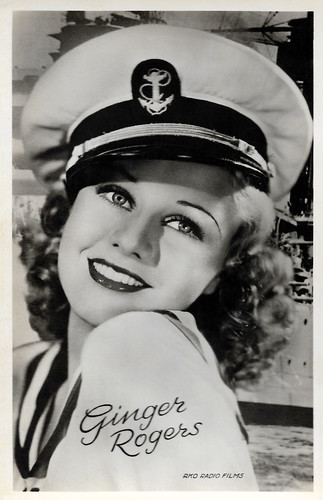
Dutch postcard by Fotoarchief Film en Toneel, no. 3252. Photo: RKO Radio Films. Ginger Rogers in Follow the Fleet (Mark Sandrich, 1936)
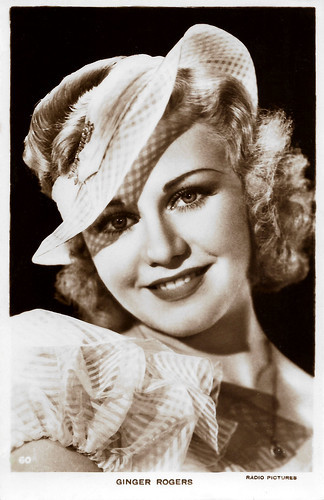
British Real Photograph postcard, no. 60. Photo: Radio Pictures.
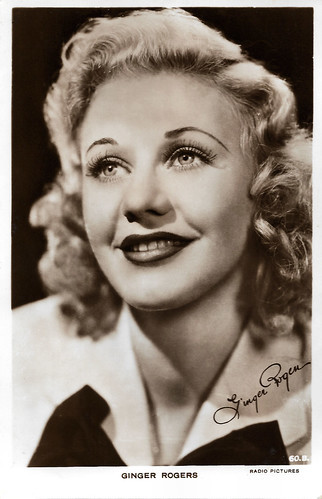
British Real Photograph postcard, no. 60.B. Photo: Radio Pictures.
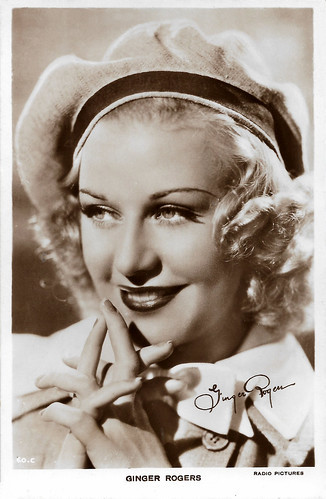
British Real Photograph postcard, no. 60.C. Photo: Radio Pictures.
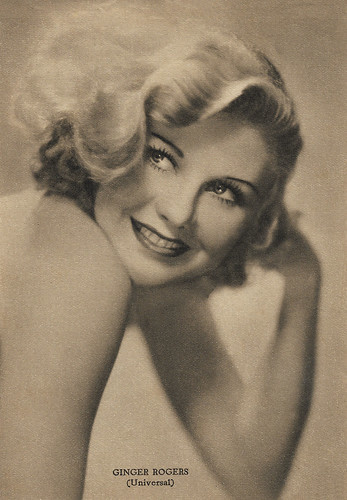
Italian postcard by Rizzoli, Milano, 1939, for Orologi e Cinturini Delgia. Photo: Universal.
Her beauty and voice were enough to have the public want more
Ginger Rogers was born Virginia Katherine McMath in 1911 in Independence, Missouri. She was the only child of Lela Emogene née Owens, a newspaper reporter, scriptwriter, and movie producer, and William Eddins McMath, an electrical engineer.
She was raised in Kansas City. In 1915, Rogers moved in with her grandparents while her mother made a trip to Hollywood in an effort to get an essay she had written made into a film. Lela succeeded and continued to write scripts for Fox Studios.
One of Rogers' young cousins, Helen, had a hard time pronouncing "Virginia", shortening it to "Badinda"; the nickname soon became "Ginga". When Rogers was nine years old, her mother remarried, to John Logan Rogers. Ginger took the surname Rogers, although she was never legally adopted. They lived in Fort Worth. Her mother became a theatre critic for a local newspaper, the Fort Worth Record.
As a teenager, Rogers thought of becoming a school teacher, but with her mother's interest in Hollywood and the theater, her early exposure to the theater increased. Waiting for her mother in the wings of the Majestic Theatre, she began to sing and dance along with the performers on stage
Rogers' entertainment career began when the traveling vaudeville act of Eddie Foy came to Fort Worth and needed a quick stand-in. In 1925, the 14-year-old entered and won a 1925 Charleston dance contest. This launched a successful vaudeville career.
Rogers made her Broadway debut in the musical 'Top Speed', which opened on Christmas Day, 1929.
Two weeks later, Rogers was chosen to star on Broadway in 'Girl Crazy' by George Gershwin and Ira Gershwin. This led to a contract with Paramount Pictures, and her first film was A Night in a Dormitory (Harry Delmar, 1930). Her contract ended after five films, all made at the Astoria Studios in Queens - and she moved with her mother to Hollywood.
At Warner Bros, Rogers had her first successful film role as in the backstage musical 42nd Street (Lloyd Bacon, 1933), starring Warner Baxter and Bebe Daniels . The choreography was staged by Busby Berkeley. The film was nominated for the Academy Award for Best Picture and was very successful at the box office. It is now considered a classic.
The film that enamoured her to the public was the musical Gold Diggers of 1933 (Mervyn LeRoy, 1933) with Warren William and Joan Blondell . She did not have top billing but her beauty and voice were enough to have the public want more. She popularised in the film the evergreen 'We're in the Money'.
Her real stardom occurred when she was teamed with Fred Astaire in Flying Down to Rio (Thornton Freeland, 1933). Throughout the 1930s, Rogers and Astaire made nine musical films at RKO, among which were some of her biggest successes: Flying Down to Rio (Thornton Freeland, 1933), The Gay Divorcee (Mark Sandrich, 1934), Roberta (William A. Seiter, 1935), Top Hat (Mark Sandrich, 1935), Follow the Fleet (Mark Sandrich, 1936), Swing Time (George Stevens, 1936), Shall We Dance (Mark Sandrich, 1937), Carefree (Mark Sandrich, 1938), and The Story of Vernon and Irene Castle (H.C. Potter, 1939).
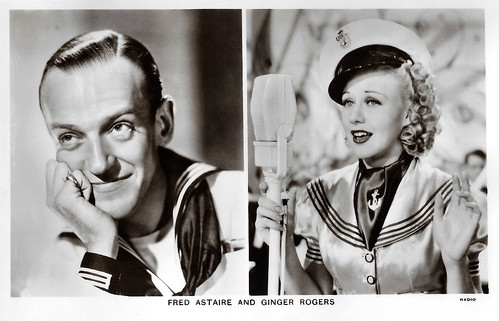
British postcard in the Film Partners Series, London, no. F 195. Photo: Radio (RKO). Fred Astaire and Ginger Rogers in Follow the Fleet (Mark Sandrich, 1936).
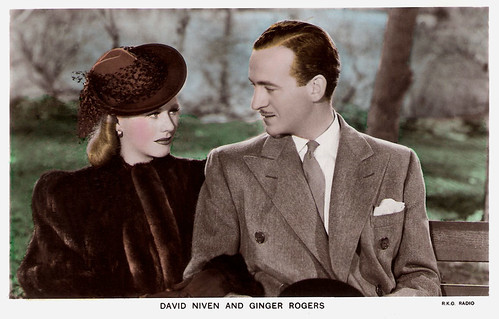
British postcard in the Film Partners Series, London, no. PC 211. Photo: R.K.O. Radio. Ginger Rogers and David Niven in Bachelor Mother (Garson Kanin, 1939).
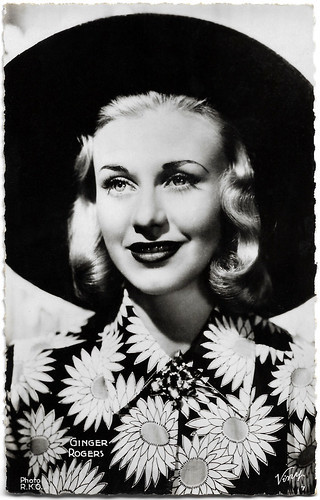
French postcard by Viny, no. 7. Photo: RKO.
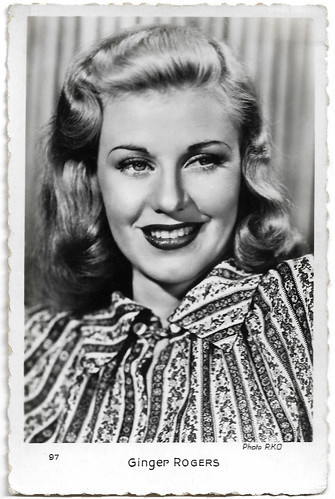
French postcard by Ed. Chantal, Paris, no. 97. Photo: RKO.
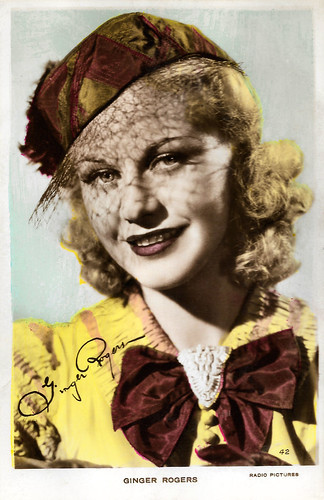
British Real Photograph postcard by Art Photo, no. 42. Photo: Radio Pictures (RKO).
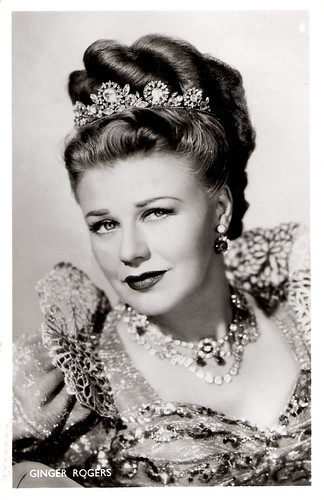
Dutch postcard by J. Sleding N.V., Amsterdam (J.S.A.), no. S 68. Photo: Universal International. Photo: Ginger Rogers in Magnificent Doll (Frank Borzage, 1946).
One of the biggest box-office draws of the 1940s
After two commercial failures with Astaire, Ginger Rogers began to branch out into dramatic films and comedies. Stage Door (Gregory La Cava, 1937) demonstrated her dramatic capacity, as the loquacious yet vulnerable girl next door, a tough-minded theatrical hopeful, opposite Katharine Hepburn .
Successful comedies included Vivacious Lady (George Stevens, 1938) with James Stewart, Fifth Avenue Girl (Gregory La Cava, 1939), where she played an out-of-work girl sucked into the lives of a wealthy family, and Bachelor Mother (Garson Kanin, 1939), with David Niven , in which she played a shop-girl who is falsely thought to have abandoned her baby.
Her acting was well-received by critics and audiences, and she became one of the biggest box-office draws of the 1940s. Her performance in Kitty Foyle (Sam Wood, 1940) won her the Academy Award for Best Actress.
She followed it with the delightful comedies Tom, Dick and Harry (Garson Kanin, 1941), and The Major and the Minor (Billy Wilder, 1942) with Ray Milland . In Roxie Hart (William A. Wellman, 1942), based on the same play which later served as the template for the musical 'Chicago', Rogers played a wisecracking flapper in a love triangle on trial for the murder of her lover; set in the era of prohibition. Most of the film takes place in a women's jail.
Rogers remained successful throughout the 1940s and at one point was Hollywood's highest-paid actress, but her popularity had peaked by the end of the decade. She reunited with Fred Astaire in the commercially successful The Barkleys of Broadway (Charles Walters, 1949).
After an unsuccessful period through the 1950s, Rogers made a successful return to Broadway in 1965, playing the lead role in 'Hello, Dolly!'. In 1969, she had the lead role in another long-running popular production, 'Mame'. More lead roles on Broadway followed. Rogers' autobiography 'Ginger: My Story' was published in 1991.
Ginger Rogers died of a heart attack in 1995 in Rancho Mirage, California, at the age of 83. Her resting place is the Oakwood Memorial Park Cemetery in Chatsworth, California. Rogers married five times with all of them ending in divorce and having no children. During her long career, she made 73 films.
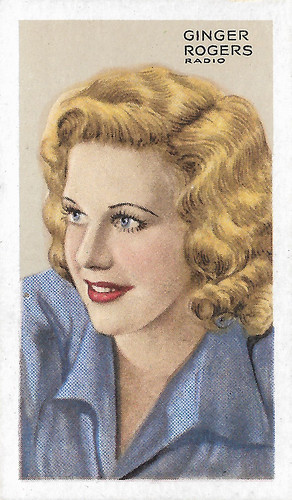
British cigarette card in the Stars of Screen & Stage series by Park Drive Cigarettes, Gallaher Ltd., London & Belfast, no. 14. Photo: Radio. Collection: Geoffrey Donaldson Institute.
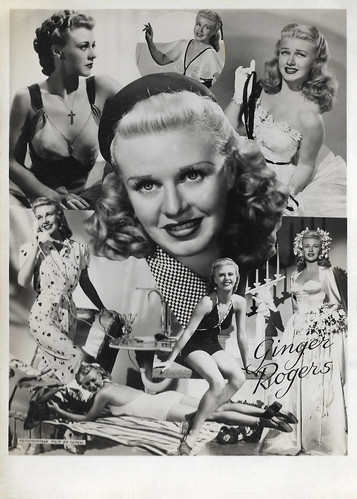
Big Dutch postcard by 't Sticht / Takken, Utrecht, no. 3145. Photo montage: Film en Toneel.
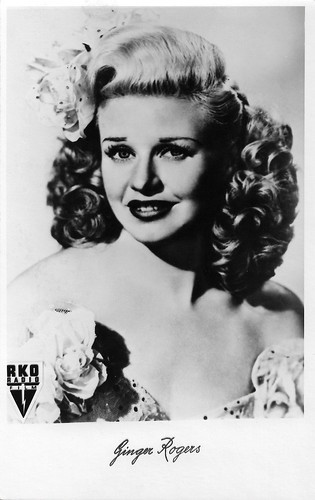
Vintage card. Photo: RKO Radio Film.
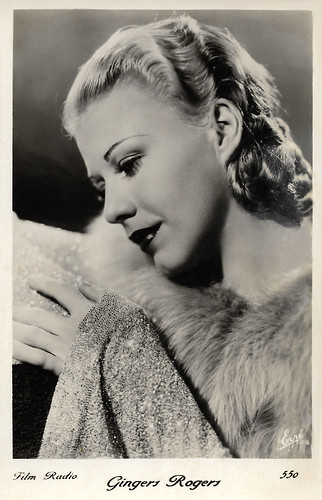
French postcard by Erpé, no. 550. Photo: Film Radio (RKO).
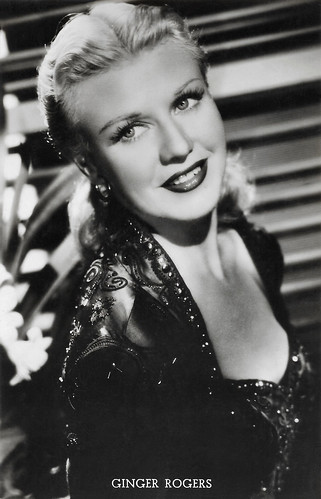
Belgian postcard, no. 351. Photo: Warner Bros.
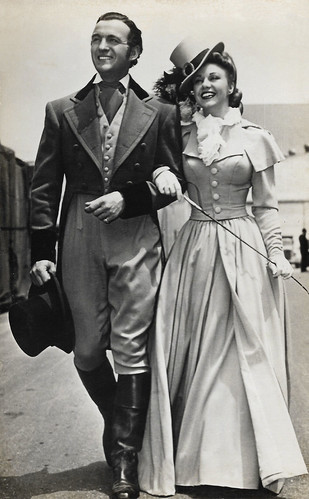
Spanish postcard. David Niven and Ginger Rogers in Magnificent Doll (Frank Borzage, 1946).
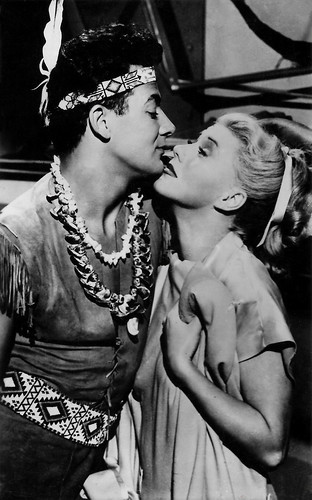
Spanish postcard, no. 741. Cornel Wilde and Ginger Rogers in It Had To Be You (Don Hartman, Rudolph Maté, 1947).
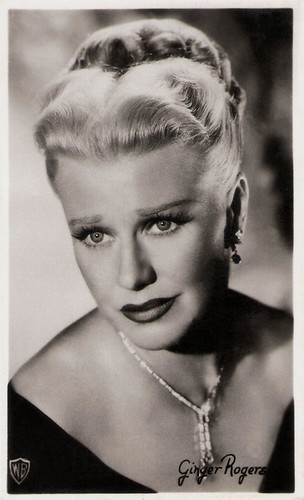
Belgian collectors card by Fotoprim, Brussels, presented by De Beukelaer, Biscuits and Chocolates, Anvers/Antwerpen (Antwerp), no. A 41. Photo: Warner Bros. Photo: Ginger Rogers in Perfect Strangers (Bretaigne Windust, 1950).
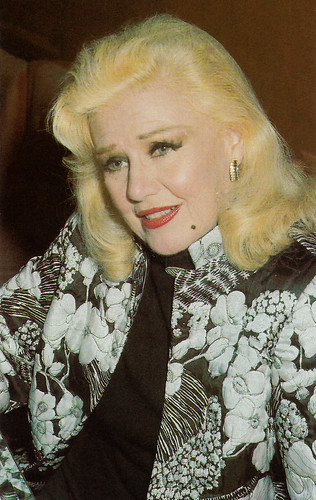
American postcard by Coral-Lee, Rancho Cordova, CA, no. 91. Photo: Anthony Rollo. Caption: 1980 Woodfin Camp.
Sources: (IMDb), Wikipedia and .

Dutch postcard by Fotoarchief Film en Toneel, no. 3252. Photo: RKO Radio Films. Ginger Rogers in Follow the Fleet (Mark Sandrich, 1936)

British Real Photograph postcard, no. 60. Photo: Radio Pictures.

British Real Photograph postcard, no. 60.B. Photo: Radio Pictures.

British Real Photograph postcard, no. 60.C. Photo: Radio Pictures.

Italian postcard by Rizzoli, Milano, 1939, for Orologi e Cinturini Delgia. Photo: Universal.
Her beauty and voice were enough to have the public want more
Ginger Rogers was born Virginia Katherine McMath in 1911 in Independence, Missouri. She was the only child of Lela Emogene née Owens, a newspaper reporter, scriptwriter, and movie producer, and William Eddins McMath, an electrical engineer.
She was raised in Kansas City. In 1915, Rogers moved in with her grandparents while her mother made a trip to Hollywood in an effort to get an essay she had written made into a film. Lela succeeded and continued to write scripts for Fox Studios.
One of Rogers' young cousins, Helen, had a hard time pronouncing "Virginia", shortening it to "Badinda"; the nickname soon became "Ginga". When Rogers was nine years old, her mother remarried, to John Logan Rogers. Ginger took the surname Rogers, although she was never legally adopted. They lived in Fort Worth. Her mother became a theatre critic for a local newspaper, the Fort Worth Record.
As a teenager, Rogers thought of becoming a school teacher, but with her mother's interest in Hollywood and the theater, her early exposure to the theater increased. Waiting for her mother in the wings of the Majestic Theatre, she began to sing and dance along with the performers on stage
Rogers' entertainment career began when the traveling vaudeville act of Eddie Foy came to Fort Worth and needed a quick stand-in. In 1925, the 14-year-old entered and won a 1925 Charleston dance contest. This launched a successful vaudeville career.
Rogers made her Broadway debut in the musical 'Top Speed', which opened on Christmas Day, 1929.
Two weeks later, Rogers was chosen to star on Broadway in 'Girl Crazy' by George Gershwin and Ira Gershwin. This led to a contract with Paramount Pictures, and her first film was A Night in a Dormitory (Harry Delmar, 1930). Her contract ended after five films, all made at the Astoria Studios in Queens - and she moved with her mother to Hollywood.
At Warner Bros, Rogers had her first successful film role as in the backstage musical 42nd Street (Lloyd Bacon, 1933), starring Warner Baxter and Bebe Daniels . The choreography was staged by Busby Berkeley. The film was nominated for the Academy Award for Best Picture and was very successful at the box office. It is now considered a classic.
The film that enamoured her to the public was the musical Gold Diggers of 1933 (Mervyn LeRoy, 1933) with Warren William and Joan Blondell . She did not have top billing but her beauty and voice were enough to have the public want more. She popularised in the film the evergreen 'We're in the Money'.
Her real stardom occurred when she was teamed with Fred Astaire in Flying Down to Rio (Thornton Freeland, 1933). Throughout the 1930s, Rogers and Astaire made nine musical films at RKO, among which were some of her biggest successes: Flying Down to Rio (Thornton Freeland, 1933), The Gay Divorcee (Mark Sandrich, 1934), Roberta (William A. Seiter, 1935), Top Hat (Mark Sandrich, 1935), Follow the Fleet (Mark Sandrich, 1936), Swing Time (George Stevens, 1936), Shall We Dance (Mark Sandrich, 1937), Carefree (Mark Sandrich, 1938), and The Story of Vernon and Irene Castle (H.C. Potter, 1939).

British postcard in the Film Partners Series, London, no. F 195. Photo: Radio (RKO). Fred Astaire and Ginger Rogers in Follow the Fleet (Mark Sandrich, 1936).

British postcard in the Film Partners Series, London, no. PC 211. Photo: R.K.O. Radio. Ginger Rogers and David Niven in Bachelor Mother (Garson Kanin, 1939).

French postcard by Viny, no. 7. Photo: RKO.

French postcard by Ed. Chantal, Paris, no. 97. Photo: RKO.

British Real Photograph postcard by Art Photo, no. 42. Photo: Radio Pictures (RKO).

Dutch postcard by J. Sleding N.V., Amsterdam (J.S.A.), no. S 68. Photo: Universal International. Photo: Ginger Rogers in Magnificent Doll (Frank Borzage, 1946).
One of the biggest box-office draws of the 1940s
After two commercial failures with Astaire, Ginger Rogers began to branch out into dramatic films and comedies. Stage Door (Gregory La Cava, 1937) demonstrated her dramatic capacity, as the loquacious yet vulnerable girl next door, a tough-minded theatrical hopeful, opposite Katharine Hepburn .
Successful comedies included Vivacious Lady (George Stevens, 1938) with James Stewart, Fifth Avenue Girl (Gregory La Cava, 1939), where she played an out-of-work girl sucked into the lives of a wealthy family, and Bachelor Mother (Garson Kanin, 1939), with David Niven , in which she played a shop-girl who is falsely thought to have abandoned her baby.
Her acting was well-received by critics and audiences, and she became one of the biggest box-office draws of the 1940s. Her performance in Kitty Foyle (Sam Wood, 1940) won her the Academy Award for Best Actress.
She followed it with the delightful comedies Tom, Dick and Harry (Garson Kanin, 1941), and The Major and the Minor (Billy Wilder, 1942) with Ray Milland . In Roxie Hart (William A. Wellman, 1942), based on the same play which later served as the template for the musical 'Chicago', Rogers played a wisecracking flapper in a love triangle on trial for the murder of her lover; set in the era of prohibition. Most of the film takes place in a women's jail.
Rogers remained successful throughout the 1940s and at one point was Hollywood's highest-paid actress, but her popularity had peaked by the end of the decade. She reunited with Fred Astaire in the commercially successful The Barkleys of Broadway (Charles Walters, 1949).
After an unsuccessful period through the 1950s, Rogers made a successful return to Broadway in 1965, playing the lead role in 'Hello, Dolly!'. In 1969, she had the lead role in another long-running popular production, 'Mame'. More lead roles on Broadway followed. Rogers' autobiography 'Ginger: My Story' was published in 1991.
Ginger Rogers died of a heart attack in 1995 in Rancho Mirage, California, at the age of 83. Her resting place is the Oakwood Memorial Park Cemetery in Chatsworth, California. Rogers married five times with all of them ending in divorce and having no children. During her long career, she made 73 films.

British cigarette card in the Stars of Screen & Stage series by Park Drive Cigarettes, Gallaher Ltd., London & Belfast, no. 14. Photo: Radio. Collection: Geoffrey Donaldson Institute.

Big Dutch postcard by 't Sticht / Takken, Utrecht, no. 3145. Photo montage: Film en Toneel.

Vintage card. Photo: RKO Radio Film.

French postcard by Erpé, no. 550. Photo: Film Radio (RKO).

Belgian postcard, no. 351. Photo: Warner Bros.

Spanish postcard. David Niven and Ginger Rogers in Magnificent Doll (Frank Borzage, 1946).

Spanish postcard, no. 741. Cornel Wilde and Ginger Rogers in It Had To Be You (Don Hartman, Rudolph Maté, 1947).

Belgian collectors card by Fotoprim, Brussels, presented by De Beukelaer, Biscuits and Chocolates, Anvers/Antwerpen (Antwerp), no. A 41. Photo: Warner Bros. Photo: Ginger Rogers in Perfect Strangers (Bretaigne Windust, 1950).

American postcard by Coral-Lee, Rancho Cordova, CA, no. 91. Photo: Anthony Rollo. Caption: 1980 Woodfin Camp.
Sources: (IMDb), Wikipedia and .
Published on April 18, 2020 22:00
April 17, 2020
New Acquisitions: German collectors cards of the 1950s
Lately, we found these great 'Sammelkarten', collectors cards from West-Germany. There is little information about the publisher or the production dates on the cards, but we guess they were produced in 1955. The cards could be glued in an album that contained the biographies of the stars. There were four series: I, "Deutsche Film-Lieblinge" (German film favourites); II, "Filmgrössen aus aller Welt" (Film greats from all over the world); III, "Filmstars von Hollywood bis Tokio" (Film stars from Hollywood to Tokyo), and IV, "Deutsche Filmstars von heute und morgen" (German film stars of today and tomorrow).
German film favourites
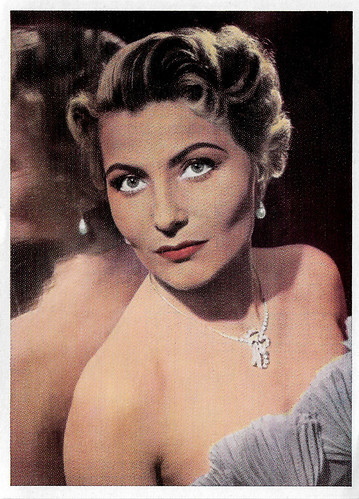
German collectors card in the "Deutsche Film-Lieblinge" series I.
Blonde Winnie Markus (1921-2002) started as a Ufa star during the Nazi period and became in the 1950s one of Germany’s most famous actresses.
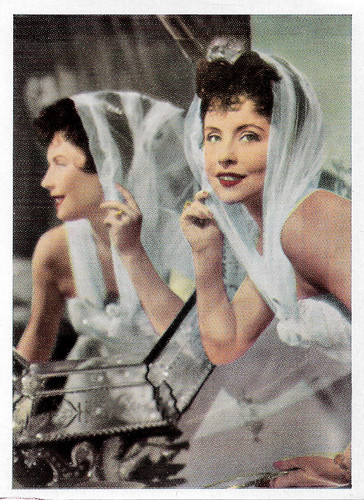
German collectors card in the "Deutsche Film-Lieblinge" series I.
Delicately lovely, dark-haired and innocent-looking Sonja Ziemann (1926-2020) was a German film and television actress, singer and dancer. Her roles in film operettas and Heimatfilms as Schwarzwaldmädel/The Black Forest Girl (1950) and Grün ist die Heide/The Heath is Green (1951) made her one of the first stars of Germany's post-war cinema. Her private life knew several tragedies.
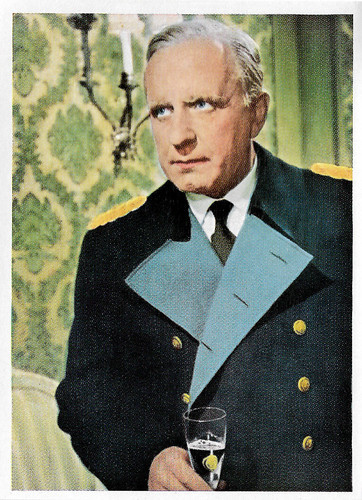
German collectors card in the "Deutsche Film-Lieblinge" series I. Photo: O.E. Hasse in Canaris (Alfred Weidenmann, 1954).
German actor and director O.E. Hasse (1903-1978) became a star of the German cinema when he was already in his fifties. He also appeared in several international productions, including Hitchcock’s I Confess (1953) and Costa-Gravas’ État de Siège/State of Siege (1972).
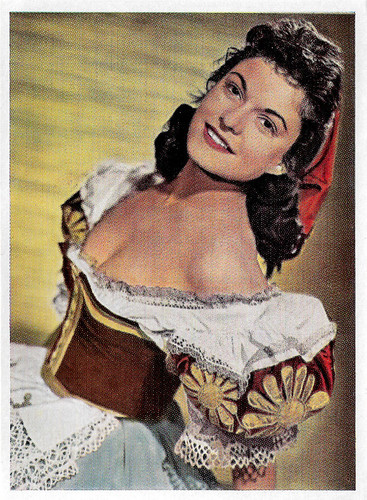
German collectors card in the "Deutsche Film-Lieblinge" series I. Photo: Margit Saad in Der Zigeunerbaron/The Gypsy Baron (Arthur Maria Rabenalt, 1954).
German actress Margit Saad (1929) was a mysterious, exotic beauty, who worked largely in German film and television. During the 1960s, she also made occasional English-language appearances.
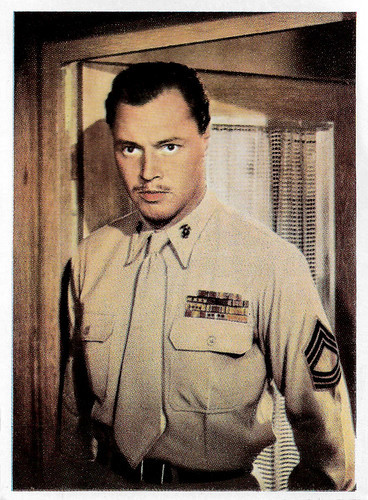
German collectors card in the "Deutsche Film-Lieblinge" series I. Photo: Ivan Desny in Die goldene Pest/The Golden Plague (John Brahm, 1954).
French-German actor Ivan Desny (1922-2002) was a cosmopolitan film star with a truly European film career that spanned four decades. In the years after the war, he appeared in British, French, Italian and German films before he became one of the protagonists of the Neue Deutsche Welle - the German New Wave of the 1970s.
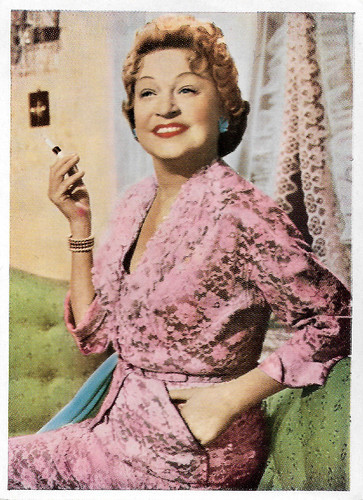
German collectors card in the "Deutsche Film-Lieblinge" series I.
Grethe Weiser (1903–1970) was a German singer, comedian, film and stage actress. She made more than 140 films.
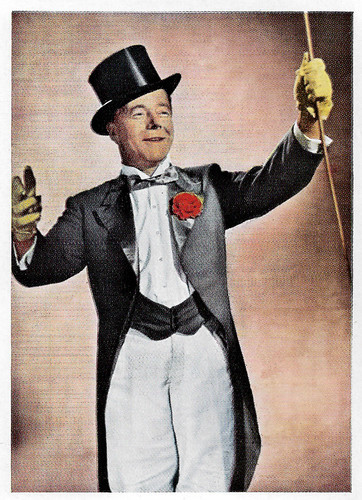
German collectors card in the "Deutsche Film-Lieblinge" series I. Heinz Rühmann in Keine Angst vor großen Tieren/Don't be afraid of big animals (Ulrich Erfurth, 1953).
Actor, director and producer Heinz Rühmann (1902-1994) played in more than 100 films over nearly 70 years and was one of Germany's most popular film stars. He was a favourite actor of Adolf Hitler and Josef Goebbels but also of Anne Frank. She pasted his photo on the wall of her room in her family's hiding place during the war, where it can still be seen today.
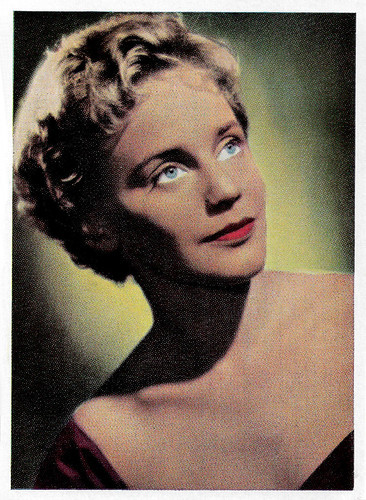
German collectors card in the "Deutsche Film-Lieblinge", series I.
Pretty, wide-eyed Austrian leading lady Maria Schell (1926-2005) became one of the first film idols to the European postwar generation. With her ‘smile under tears’, she appeared in dozens of German and Austrian popular films, but she also starred in British, French, Italian, and Hollywood productions.
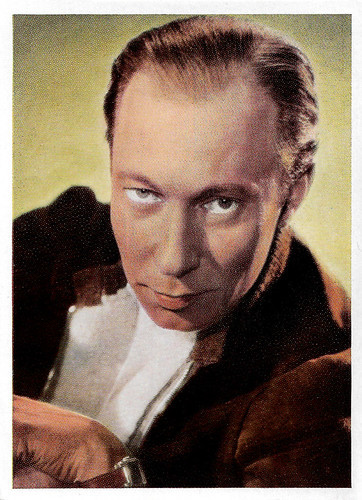
German collectors card in the "Deutsche Film-Lieblinge", series I.
German actor Carl Raddatz (1912-2004) was much in demand by film producers in the 1940s and especially in the 1950s. He appeared in several Nazi propaganda films, but he also gave Joseph Stalin a German voice. Through the years he would become one of the leading character actors of the German theatre.
Film greats from all over the world
German collectors card in the 'Filmgrössen aus aller Welt" series II. Spencer Tracy in A Guy Named Joe (Victor Fleming, 1943).
American actor Spencer Tracy (1900-1967) was one of the major stars of Hollywood's Golden Age. He was the first actor to win back-to-back Oscars for Captains Courageous (1937) with Freddie Bartholomew, and for playing Father Edward Flanagan in Boys Town (1938) with Mickey Rooney. Considered by his peers as one of the best Hollywood actors, Tracy was noted for his natural performing style and versatility.
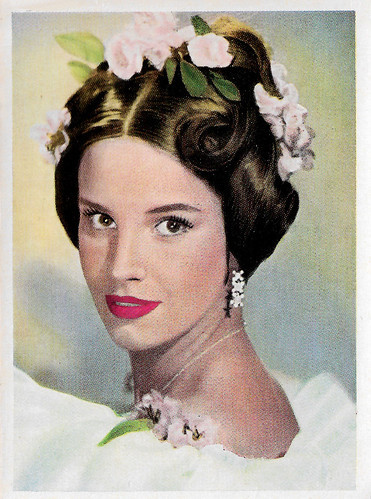
German collectors card in the "Filmgrössen aus aller Welt", series II. Antonella Lualdi in Le rouge et le noir/The Red and the Black (Claude Autant-Lara, 1954).
Italo-Greek Antonella Lualdi (1931) was the fascinating leading lady of many Italian and French films of the 1950s and 1960s. Since 1949 her luminescent beauty has graced over 90 films.
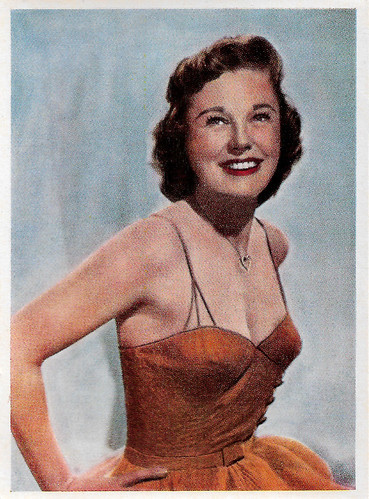
German collectors card in the "Filmgrössen aus aller Welt", series II.
June Allyson (1917-2006) was an American stage, film, and television actress, dancer, and singer. Her sweet smile and sunny disposition made her the prototypical girl-next-door of American films of the 1940s.
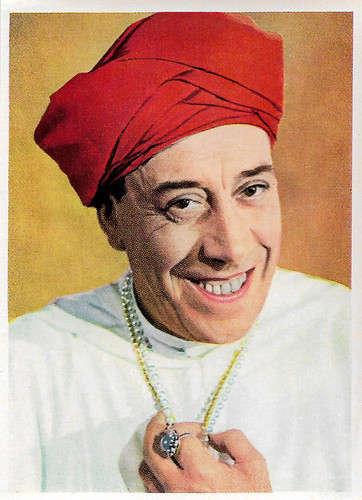
German collectors card in the "Filmgrössen aus aller Welt" series II. Fernandel in Ali Baba et les 40 voleurs/Ali Baba and the Forty Thieves (Jacques Becker, 1954).
Actor and singer Fernandel (1903-1971) was for more than forty years France's top comedy star. He was perhaps best-loved for his portrayal of Don Camillo. His horse-like teeth and shy manner became his trademark.
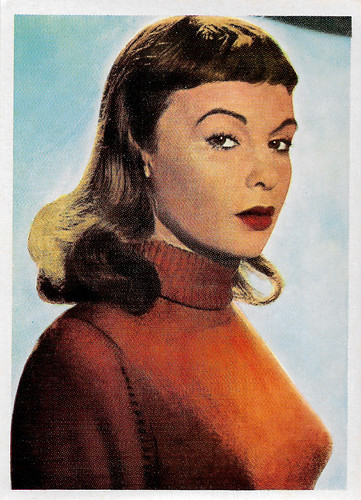
German collectors card in the "Filmgrössen aus aller Welt" series II. Françoise Arnoul in Les compagnes de la nuit/Companions of the Night (Ralph Habib, 1953).
Pretty and petite actress Françoise Arnoul (1931) was in the early 1950s presented as the new French sex symbol but soon she would be overshadowed by the spectacular Brigitte Bardot. But, Arnoul had enough talent and range to forge a decent film career for herself.
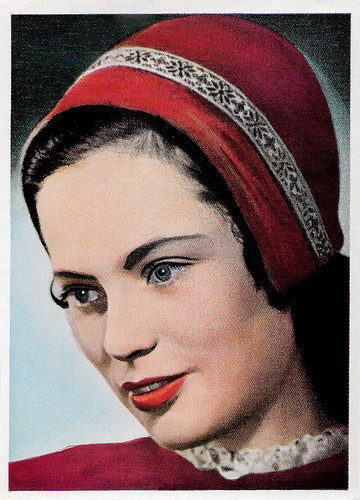
German collectors card in the 'Filmgrössen aus aller Welt" series II. Ulla Jacobsson in Herr Arnes penningar/Sir Arne's Treasure (Gustaf Molander, 1954).
Swedish film and stage actress Ulla Jacobsson (1929-1982) achieved international fame with a nude scene in her second film, Hon dansade en sommar/One Summer of Happiness (1951). Another highlight was her serene performance in Ingmar Bergman's Sommarnattens leende/Smiles of a Summer Night (1955).
Film stars from Hollywood to Tokyo
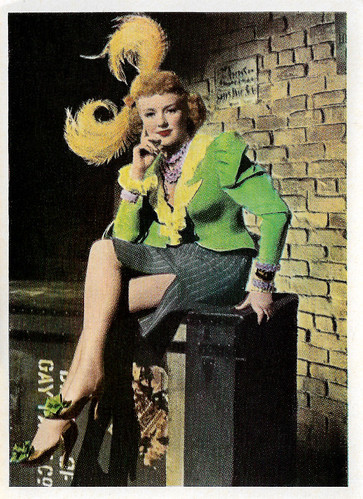
German collectors card in the "Filmstars von Hollywood bis Tokio" series III. Betty Grable in Wabash Avenue (Henry Koster, 1950).
American film star Betty Grable (1916-1973) was known as 'The Girl With the Million Dollar Legs'. During World War II, the quicksilver blonde's famous pin-up pose - in a bathing suit, back to the camera, smiling over her right shoulder - adorned barracks all around the world. Her 42 films during the 1930s, 1940s, and 1950s grossed more than $100 million. One of her biggest successes was the comedy How to Marry a Millionaire (1953), which was also one of her last films.
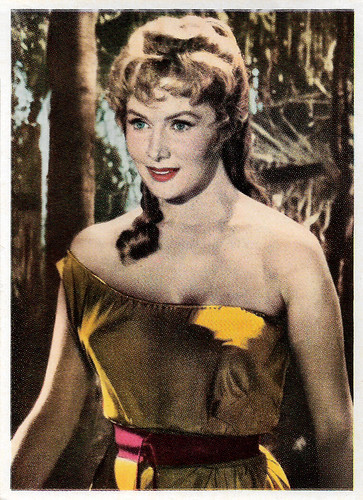
German collectors card in the "Filmstars von Hollywood bis Tokio" series III. Rhonda Fleming in La cortigiana di Babilonia/The Queen of Babylon (Carlo Ludovico Bragaglia, 1954).
American film and television actress Rhonda Fleming (1923) acted in more than forty films, mostly in the 1940s and 1950s, and became renowned as one of the most beautiful and glamorous actresses of her day. She was nicknamed the 'Queen of Technicolor' because her fair complexion and flaming red hair photographed exceptionally well in Technicolor.

German collectors card in the "Filmstars von Hollywood bis Tokio" series III. Photo: Vivien Leigh in The Deep Blue Sea (Anatole Litvak, 1955).
Extraordinarily beautiful British actress Vivien Leigh (1913-1967) won two Academy Awards for playing ‘Southern belles’: Scarlett O'Hara in Gone with the Wind (1939) and Blanche DuBois in A Streetcar Named Desire (1951). On stage she starred – often with her husband, Laurence Olivier - in parts that ranged from the heroines of Noël Coward and George Bernard Shaw comedies to Shakespearean characters like Ophelia, Juliet, and Lady Macbeth.
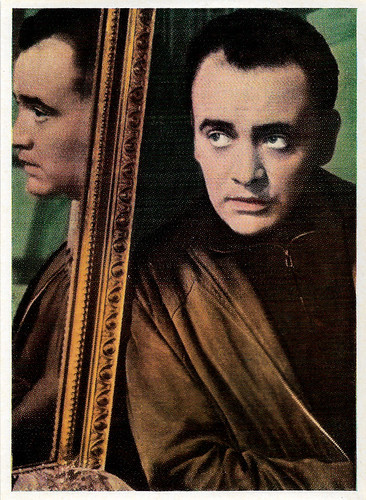
German collectors card in the "Filmstars von Hollywood bis Tokio" series III.
French actor Raymond Pellegrin (1925-2007) had the most beautiful voice of the French cinema. He appeared in more than 120 European films, both as good and as bad guys.
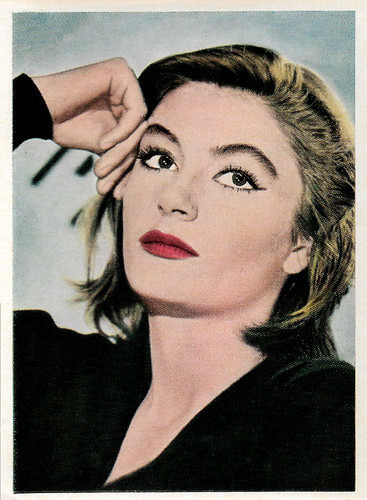
German collectors card in the "Filmstars von Hollywood bis Tokio" series III. Photo: Gabriele. Anouk Aimée in Ich suche dich/I search for you (O.W. Fischer, 1956).
Glamorous French film actress Anouk Aimée (1932) has appeared in 70 films since 1947 and worked with many talented directors. She had major international successes in the 1960s with Lola (1961) and Un homme et une femme/A Man and a Woman (1966) in which she defined a new kind of modern heroine.
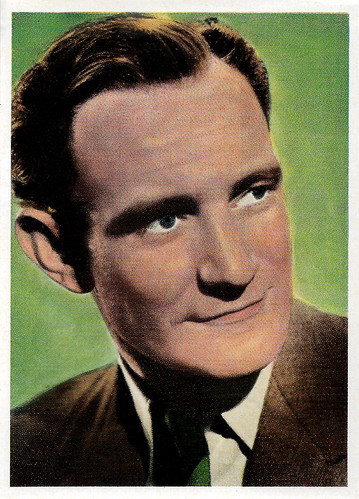
German collectors card in the "Filmstars von Hollywood bis Tokio" series III.
An English film, stage and television actor Trevor Howard (1913-1988) is best known as the doctor in the classic romantic drama Brief Encounter (David Lean, 1945), in which his co-star was Celia Johnson. In the 1940s and 1950s, he often played the slightly dry, slightly crusty but capable British military officer, and in the 1960s he became one of England's finest character actors.
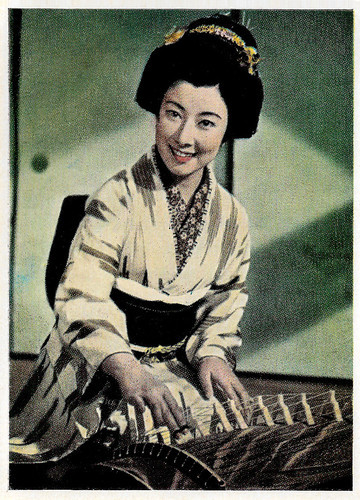
German collectors card in the "Filmstars von Hollywood bis Tokio" series III.
Fujiko Yamamoto (1931) is a Japanese film and stage actress. She appeared in over 100 films between 1953 and 1963. She was one of the top actresses of the Daei studio.
German film stars of today and tomorrow
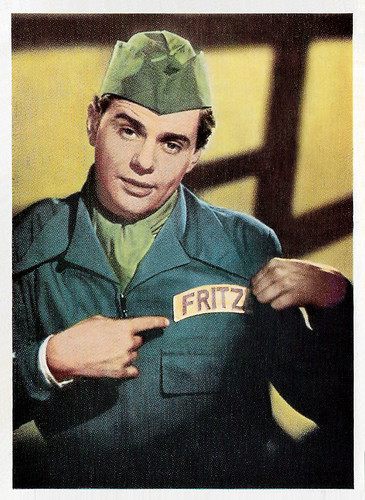
German collectors card in the "Deutsche Filmstars von heute und morgen" series IV. Walter Giller in Die Drei von der Tankstelle/The Three from the Filling Station (Hans Wolff, 1955).
German actor Walter Giller (1927-2011) was the cute boy next door of the German cinema of the 1950s. With Nadja Tiller , he became a Dream Couple of the European cinema.
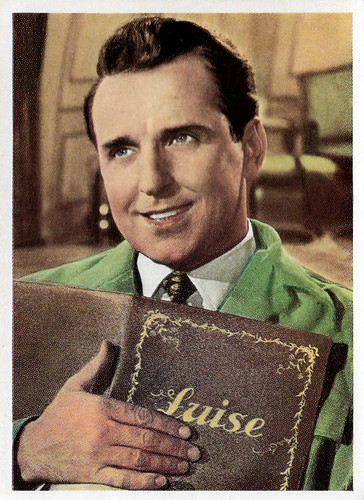
German collectors card in the "Deutsche Filmstars von heute und morgen" series IV. Georg Thomalla in Bezauberndes Fräulein/Adorable Miss (Georg Thomalla, 1953).
German actor Georg Thomalla (1915-1999) was one of the most popular and prolific character comedians of the post-war German cinema. Thomalla was also known in Germany for dubbing Peter Sellers as Inspector Clouseau and Jack Lemmon from 1955 to 1998.
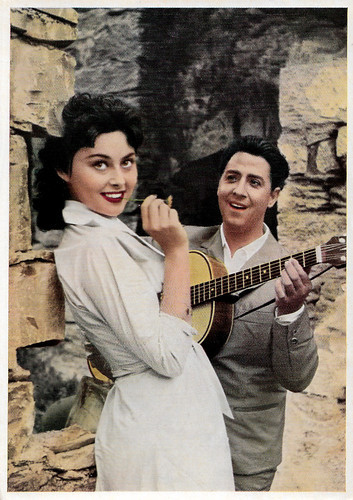
German collectors card in the "Deutsche Filmstars von heute und morgen" series IV. Elma Karlowa and Vico Torriani in Gitarren der Liebe/Guitars of Love (Werner Jacobs, 1954).
Yugoslav actress Elma Karlowa (1932-1994) was a star of the German popular cinema of the 1950s and early 1960s. After a personal crisis, she returned to the screen in more serious films by directors like Rainer Werner Fassbinder.
Swiss Schlager singer and actor Vico Torriani (1920-1998) was also a popular TV show master and an author of cookbooks. In the 1950s and early 1960s, he starred in a dozen German film musicals and comedies. The favourite Son of Switzerland sold more than twenty million records.
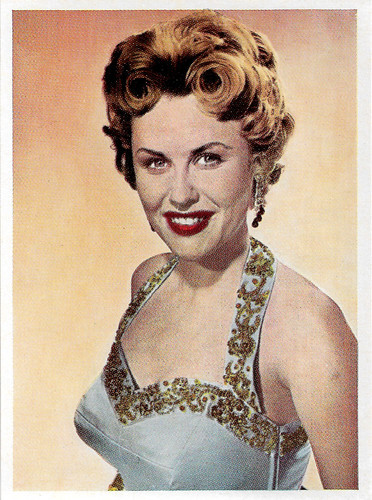
German collectors card in the "Deutsche Filmstars von heute und morgen", series IV.
Blond Swedish pop singer and actress Bibi Johns (1929) was very popular in Europe and the USA during the 1950s. She appeared in several European musical films. In Germany, where she lived from 1954 on, she would become a cult star of the Schlager music. Today she is also known as a painter.
German film favourites

German collectors card in the "Deutsche Film-Lieblinge" series I.
Blonde Winnie Markus (1921-2002) started as a Ufa star during the Nazi period and became in the 1950s one of Germany’s most famous actresses.

German collectors card in the "Deutsche Film-Lieblinge" series I.
Delicately lovely, dark-haired and innocent-looking Sonja Ziemann (1926-2020) was a German film and television actress, singer and dancer. Her roles in film operettas and Heimatfilms as Schwarzwaldmädel/The Black Forest Girl (1950) and Grün ist die Heide/The Heath is Green (1951) made her one of the first stars of Germany's post-war cinema. Her private life knew several tragedies.

German collectors card in the "Deutsche Film-Lieblinge" series I. Photo: O.E. Hasse in Canaris (Alfred Weidenmann, 1954).
German actor and director O.E. Hasse (1903-1978) became a star of the German cinema when he was already in his fifties. He also appeared in several international productions, including Hitchcock’s I Confess (1953) and Costa-Gravas’ État de Siège/State of Siege (1972).

German collectors card in the "Deutsche Film-Lieblinge" series I. Photo: Margit Saad in Der Zigeunerbaron/The Gypsy Baron (Arthur Maria Rabenalt, 1954).
German actress Margit Saad (1929) was a mysterious, exotic beauty, who worked largely in German film and television. During the 1960s, she also made occasional English-language appearances.

German collectors card in the "Deutsche Film-Lieblinge" series I. Photo: Ivan Desny in Die goldene Pest/The Golden Plague (John Brahm, 1954).
French-German actor Ivan Desny (1922-2002) was a cosmopolitan film star with a truly European film career that spanned four decades. In the years after the war, he appeared in British, French, Italian and German films before he became one of the protagonists of the Neue Deutsche Welle - the German New Wave of the 1970s.

German collectors card in the "Deutsche Film-Lieblinge" series I.
Grethe Weiser (1903–1970) was a German singer, comedian, film and stage actress. She made more than 140 films.

German collectors card in the "Deutsche Film-Lieblinge" series I. Heinz Rühmann in Keine Angst vor großen Tieren/Don't be afraid of big animals (Ulrich Erfurth, 1953).
Actor, director and producer Heinz Rühmann (1902-1994) played in more than 100 films over nearly 70 years and was one of Germany's most popular film stars. He was a favourite actor of Adolf Hitler and Josef Goebbels but also of Anne Frank. She pasted his photo on the wall of her room in her family's hiding place during the war, where it can still be seen today.

German collectors card in the "Deutsche Film-Lieblinge", series I.
Pretty, wide-eyed Austrian leading lady Maria Schell (1926-2005) became one of the first film idols to the European postwar generation. With her ‘smile under tears’, she appeared in dozens of German and Austrian popular films, but she also starred in British, French, Italian, and Hollywood productions.

German collectors card in the "Deutsche Film-Lieblinge", series I.
German actor Carl Raddatz (1912-2004) was much in demand by film producers in the 1940s and especially in the 1950s. He appeared in several Nazi propaganda films, but he also gave Joseph Stalin a German voice. Through the years he would become one of the leading character actors of the German theatre.
Film greats from all over the world
German collectors card in the 'Filmgrössen aus aller Welt" series II. Spencer Tracy in A Guy Named Joe (Victor Fleming, 1943).
American actor Spencer Tracy (1900-1967) was one of the major stars of Hollywood's Golden Age. He was the first actor to win back-to-back Oscars for Captains Courageous (1937) with Freddie Bartholomew, and for playing Father Edward Flanagan in Boys Town (1938) with Mickey Rooney. Considered by his peers as one of the best Hollywood actors, Tracy was noted for his natural performing style and versatility.

German collectors card in the "Filmgrössen aus aller Welt", series II. Antonella Lualdi in Le rouge et le noir/The Red and the Black (Claude Autant-Lara, 1954).
Italo-Greek Antonella Lualdi (1931) was the fascinating leading lady of many Italian and French films of the 1950s and 1960s. Since 1949 her luminescent beauty has graced over 90 films.

German collectors card in the "Filmgrössen aus aller Welt", series II.
June Allyson (1917-2006) was an American stage, film, and television actress, dancer, and singer. Her sweet smile and sunny disposition made her the prototypical girl-next-door of American films of the 1940s.

German collectors card in the "Filmgrössen aus aller Welt" series II. Fernandel in Ali Baba et les 40 voleurs/Ali Baba and the Forty Thieves (Jacques Becker, 1954).
Actor and singer Fernandel (1903-1971) was for more than forty years France's top comedy star. He was perhaps best-loved for his portrayal of Don Camillo. His horse-like teeth and shy manner became his trademark.

German collectors card in the "Filmgrössen aus aller Welt" series II. Françoise Arnoul in Les compagnes de la nuit/Companions of the Night (Ralph Habib, 1953).
Pretty and petite actress Françoise Arnoul (1931) was in the early 1950s presented as the new French sex symbol but soon she would be overshadowed by the spectacular Brigitte Bardot. But, Arnoul had enough talent and range to forge a decent film career for herself.

German collectors card in the 'Filmgrössen aus aller Welt" series II. Ulla Jacobsson in Herr Arnes penningar/Sir Arne's Treasure (Gustaf Molander, 1954).
Swedish film and stage actress Ulla Jacobsson (1929-1982) achieved international fame with a nude scene in her second film, Hon dansade en sommar/One Summer of Happiness (1951). Another highlight was her serene performance in Ingmar Bergman's Sommarnattens leende/Smiles of a Summer Night (1955).
Film stars from Hollywood to Tokyo

German collectors card in the "Filmstars von Hollywood bis Tokio" series III. Betty Grable in Wabash Avenue (Henry Koster, 1950).
American film star Betty Grable (1916-1973) was known as 'The Girl With the Million Dollar Legs'. During World War II, the quicksilver blonde's famous pin-up pose - in a bathing suit, back to the camera, smiling over her right shoulder - adorned barracks all around the world. Her 42 films during the 1930s, 1940s, and 1950s grossed more than $100 million. One of her biggest successes was the comedy How to Marry a Millionaire (1953), which was also one of her last films.

German collectors card in the "Filmstars von Hollywood bis Tokio" series III. Rhonda Fleming in La cortigiana di Babilonia/The Queen of Babylon (Carlo Ludovico Bragaglia, 1954).
American film and television actress Rhonda Fleming (1923) acted in more than forty films, mostly in the 1940s and 1950s, and became renowned as one of the most beautiful and glamorous actresses of her day. She was nicknamed the 'Queen of Technicolor' because her fair complexion and flaming red hair photographed exceptionally well in Technicolor.

German collectors card in the "Filmstars von Hollywood bis Tokio" series III. Photo: Vivien Leigh in The Deep Blue Sea (Anatole Litvak, 1955).
Extraordinarily beautiful British actress Vivien Leigh (1913-1967) won two Academy Awards for playing ‘Southern belles’: Scarlett O'Hara in Gone with the Wind (1939) and Blanche DuBois in A Streetcar Named Desire (1951). On stage she starred – often with her husband, Laurence Olivier - in parts that ranged from the heroines of Noël Coward and George Bernard Shaw comedies to Shakespearean characters like Ophelia, Juliet, and Lady Macbeth.

German collectors card in the "Filmstars von Hollywood bis Tokio" series III.
French actor Raymond Pellegrin (1925-2007) had the most beautiful voice of the French cinema. He appeared in more than 120 European films, both as good and as bad guys.

German collectors card in the "Filmstars von Hollywood bis Tokio" series III. Photo: Gabriele. Anouk Aimée in Ich suche dich/I search for you (O.W. Fischer, 1956).
Glamorous French film actress Anouk Aimée (1932) has appeared in 70 films since 1947 and worked with many talented directors. She had major international successes in the 1960s with Lola (1961) and Un homme et une femme/A Man and a Woman (1966) in which she defined a new kind of modern heroine.

German collectors card in the "Filmstars von Hollywood bis Tokio" series III.
An English film, stage and television actor Trevor Howard (1913-1988) is best known as the doctor in the classic romantic drama Brief Encounter (David Lean, 1945), in which his co-star was Celia Johnson. In the 1940s and 1950s, he often played the slightly dry, slightly crusty but capable British military officer, and in the 1960s he became one of England's finest character actors.

German collectors card in the "Filmstars von Hollywood bis Tokio" series III.
Fujiko Yamamoto (1931) is a Japanese film and stage actress. She appeared in over 100 films between 1953 and 1963. She was one of the top actresses of the Daei studio.
German film stars of today and tomorrow

German collectors card in the "Deutsche Filmstars von heute und morgen" series IV. Walter Giller in Die Drei von der Tankstelle/The Three from the Filling Station (Hans Wolff, 1955).
German actor Walter Giller (1927-2011) was the cute boy next door of the German cinema of the 1950s. With Nadja Tiller , he became a Dream Couple of the European cinema.

German collectors card in the "Deutsche Filmstars von heute und morgen" series IV. Georg Thomalla in Bezauberndes Fräulein/Adorable Miss (Georg Thomalla, 1953).
German actor Georg Thomalla (1915-1999) was one of the most popular and prolific character comedians of the post-war German cinema. Thomalla was also known in Germany for dubbing Peter Sellers as Inspector Clouseau and Jack Lemmon from 1955 to 1998.

German collectors card in the "Deutsche Filmstars von heute und morgen" series IV. Elma Karlowa and Vico Torriani in Gitarren der Liebe/Guitars of Love (Werner Jacobs, 1954).
Yugoslav actress Elma Karlowa (1932-1994) was a star of the German popular cinema of the 1950s and early 1960s. After a personal crisis, she returned to the screen in more serious films by directors like Rainer Werner Fassbinder.
Swiss Schlager singer and actor Vico Torriani (1920-1998) was also a popular TV show master and an author of cookbooks. In the 1950s and early 1960s, he starred in a dozen German film musicals and comedies. The favourite Son of Switzerland sold more than twenty million records.

German collectors card in the "Deutsche Filmstars von heute und morgen", series IV.
Blond Swedish pop singer and actress Bibi Johns (1929) was very popular in Europe and the USA during the 1950s. She appeared in several European musical films. In Germany, where she lived from 1954 on, she would become a cult star of the Schlager music. Today she is also known as a painter.
Published on April 17, 2020 22:00
April 16, 2020
Meryl Streep
American actress Meryl Streep (1949) is one of the best actresses of her generation, known for her versatility and accents. She has been nominated for the Oscar an astonishing 21 times and has won it three times. Among her other accolades, she has received 32 Golden Globe nominations, more than any other person, and won eight.
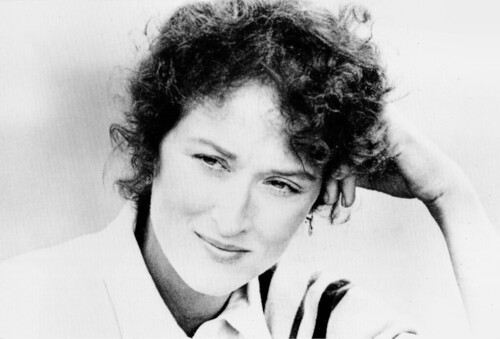
British postcard, no. 140.

American postcard by Fotofolio, New York, NY, no. P 432. Photo: Brigitte Lacombe, 1988.
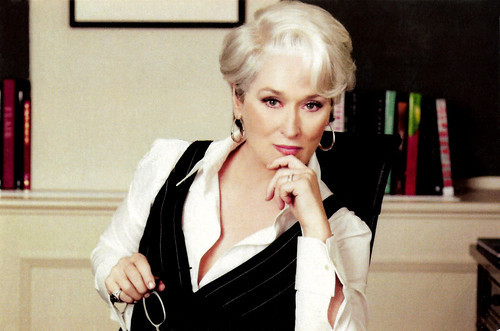
Ukrainian postcard by Magicard.biz.ua. Meryl Streep in The Devil Wears Prada (David Frankel, 2006).
A real beauty bringing much freshness
Mary Louise 'Meryl' Streep was born in 1949, in Summit, New Jersey. She is the daughter of Mary Wilkinson Streep (née Mary Wolf Wilkinson), a commercial artist and art editor; and Harry William Streep, Jr., a pharmaceutical executive. She has two younger brothers: Harry William Streep III and Dana David Streep, who are also actors.
At the age of 12, Streep was selected to sing at a school recital, leading to her having opera lessons from Estelle Liebling. She quit after four years. Although Streep appeared in numerous school plays during her high school years, she was uninterested in serious theatre until acting in the play 'Miss Julie' at Vassar College in 1969, in which she gained attention across the campus.
She received her B.A. cum laude from the college in 1971, before applying for an MFA from the Yale School of Drama. Streep played a variety of roles on stage, from Helena in 'A Midsummer Night's Dream' to an 80-year-old woman in a wheelchair in a comedy written by then-unknown playwrights Christopher Durang and Albert Innaurato.
She received her MFA from Yale in 1975. That year, Streep made her stage debut in New York in 'Trelawny of the Wells' by Arthur Wing Pinero. The following year, she received a Tony Award nomination for Best Featured Actress in a Play for appearing in the 1976 double bill of '27 Wagons Full of Cotton' by Tennessee Williams and 'A Memory of Two Mondays' by Arthur Miller.
She made her screen debut in the television film The Deadliest Season (Robert Markowitz, 1977), a sports drama with Michael Moriarty. Her film debut was the award-winning Holocaust drama Julia (Fred Zinnemann, 1977), starring Jane Fonda and Vanessa Redgrave . It is based on a chapter from Lillian Hellman's book 'Pentimento' about the author's relationship with a lifelong friend, 'Julia,' who fought against the Nazis in the years prior to World War II. Streep had a small role during a flashback sequence.
She received her first Oscar nomination for the epic war drama The Deer Hunter (Michael Cimino, 1978). Critic Pauline Kael remarked that she was a "real beauty" who brought much freshness to the film with her performance. The film, starring Robert De Niro and Christopher Walken, was also successful at the box office, grossing $49 million.
She also won an Emmy Award for her role in the miniseries Holocaust (Marvin J. Chomsky, 1978), which recounts the trajectory of the Holocaust from the perspectives of the fictional Weiss family of German Jews and that of a rising member of the SS (Michael Moriarty), who gradually becomes a merciless war criminal.
Streep travelled to Germany and Austria for filming while her partner, actor John Cazale, who had been diagnosed with lung cancer, remained in New York. Upon her return, Streep found that Cazale's illness had progressed, and she nursed him until his death in March 1978.
Streep starred opposite Dustin Hoffman in the legal drama Kramer vs. Kramer (Robert Benton, 1979). It tells the story of a couple's divorce, its impact on their young son (Justin Henry), and the subsequent evolution of their relationship and views on parenting. For Kramer vs. Kramer, Streep won both the Golden Globe Award and the Academy Award for Best Supporting Actress, which she famously left in the ladies' room after giving her speech.
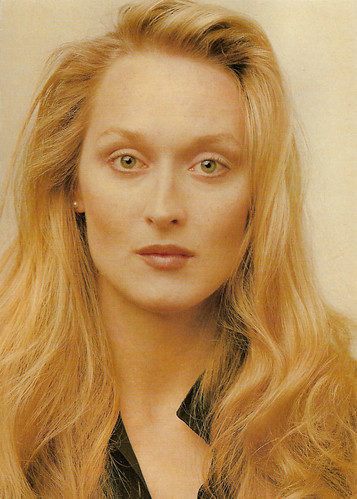
British postcard by Star Graphics, London, no. S 127.
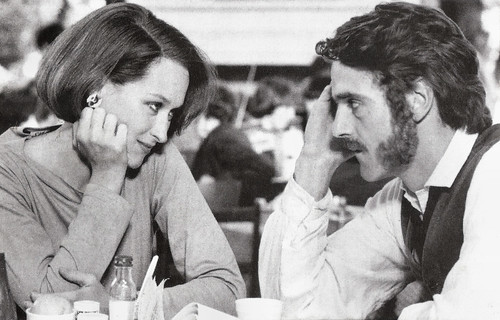
British postcard. Photo: Meryl Streep and Jeremy Irons in The French Lieutenant's Woman (Karel Reisz, 1981).
Portraying a Polish survivor of Auschwitz
Meryl Streep's first leading role was in the British romantic drama The French Lieutenant's Woman (Karel Reisz, 1981), a story within a story drama. The film paired Streep with Jeremy Irons as contemporary actors, telling their modern story, as well as the Victorian era drama they were performing. She got an Oscar nomination for her performance.
Streep won the Oscar for Best Actress for Sophie's Choice (Alan J. Pakula, 1982). Streep was very determined to get the role. After obtaining a bootlegged copy of the script, she went after Pakula, and threw herself on the ground, begging him to give her the part. She portrayed a Polish survivor of Auschwitz, caught in a love triangle between a young naïve writer (Peter MacNicol) and a Jewish intellectual (Kevin Kline).
Janet Maslin of The New York Times wrote: "Though it's far from a flawless movie, 'Sophie's Choice' is a unified and deeply affecting one. Thanks in large part to Miss Streep's bravura performance, it's a film that casts a powerful, uninterrupted spell."
In 1983, Streep played her first non-fictional character, the nuclear whistleblower and labor union activist Karen Silkwood, who died in a suspicious car accident while investigating alleged wrongdoing at the Kerr-McGee plutonium plant, in Mike Nichols' biographical drama Silkwood (Mike Nichols, 1983) with Cher.
Then she portrayed a fighter for the French Resistance during World War II in the British drama Plenty (Fred Schepisi, 1985), adapted from the play by David Hare. Her next release, the epic romantic drama Out of Africa (Sydney Pollack, 1985), established her as a Hollywood superstar. In the film, Streep starred as the Danish writer Karen Blixen, opposite Robert Redford's Denys Finch Hatton. It earned her another Oscar nomination.
Karina Longworth notes in 'Meryl Streep: Anatomy of an Actor' (2013) that the dramatic success of Out of Africa led to a backlash of critical opinion against Streep in the years that followed, especially as she was now demanding $4 million a picture. Unlike other stars at the time, such as Sylvester Stallone and Tom Cruise, Streep "never seemed to play herself", and certain critics felt her technical finesse led people to literally see her acting.
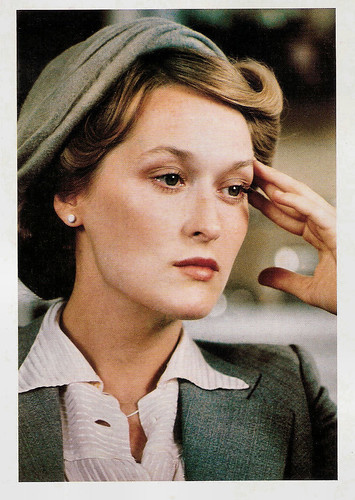
French postcard by Editions "Humour à la Carte", Paris, no. ST-121. Photo: Meryl Streep in Plenty (Fred Schepisi, 1985).
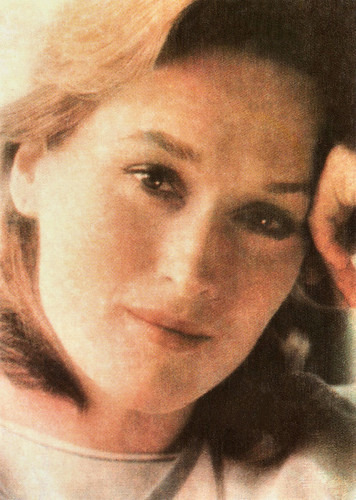
Romanian postcard by Acin in the Colectia Cinefilului.
One of the greatest performances of her career
Meryl Streep's other Oscar-nominated roles were in Ironweed (Héctor Babenco, 1987) with Jack Nicholson , the Australian drama Evil Angels/A Cry in the Dark (Fred Schepisi, 1988), the comedy-drama Postcards from the Edge (Mike Nichols, 1990) with Shirley MacLaine, the romantic drama The Bridges of Madison County (Clint Eastwood, 1995), One True Thing (Carl Franklin, 1998) with Renee Zellweger, the musical drama Music of the Heart (Wes Craven, 1999), Adaptation (Spike Jonze, 2002) starring Nicholas Cage, the comedy-drama The Devil Wears Prada (David Frankel, 2006) with Anne Hathaway, the period drama Doubt (John Patrick Shanley, 2008), the comedy-drama Julie & Julia (Nora Ephron, 2009) with Amy Adams, August: Osage County (John Wells, 2013) with Julia Roberts, the musical fantasy Into the Woods (Rob Marshall, 2014), the biographical comedy-drama Florence Foster Jenkins (Stephen Frears, 2016) with Hugh Grant , and the historical political thriller The Post (Steven Spielberg, 2017), starring Tom Hanks.
Streep won the Best Actress Oscar again for The Iron Lady (Phyllida Lloyd, 2011), the British-French biographical drama based on the life and career of Margaret Thatcher. While the film was met with mixed reviews, Streep's performance was widely acclaimed and considered to be one of the greatest of her career.
Her stage roles include The Public Theater's 2001 revival of 'The Seagull', and her television roles include two projects for HBO, the acclaimed miniseries Angels in America (Mike Nichols, 2003), for which her performance won her another Emmy Award, and the drama series Big Little Lies (Andrea Arnold, 2019). Streep has also been the recipient of many honorary awards. She was awarded Commander of the Order of the Arts and Letters by French culture minister Jean-Jacques Aillagon in 2003.
In the cinema, she appeared as Emmeline Pankhurst, a British political activist, and leader of the British suffragette movement who helped women win the right to vote in the period drama Suffragette (Sarah Gavron, 2015), co-starring Carey Mulligan and Helena Bonham Carter. Streep reprised the role of Donna Sheridan in the musical sequel Mamma Mia! Here We Go Again (Ol Parker, 2018). She also played a supporting part in Mary Poppins Returns (Rob Marshall, ), starring Emily Blunt in the title role.
In 2019, she starred in the biographical comedy The Laundromat (Steven Soderberg, 2019), the first Netflix film in which Streep starred. The film focused on the Panama Papers in particular and Beneficial ownership in general. Streep was whistleblower John Doe who released incriminating documents to the media. In addition, she played Aunt March in Little Women (Greta Gerwig, 2019).
Despite her stardom, for decades Streep has managed to maintain a relatively normal personal life. Streep lived with actor John Cazale for three years until his death from lung cancer in March 1978. Streep married sculptor Don Gummer six months after Cazale's death. They have four children: one son and three daughters, son Henry Wolfe Gummer (1979), a musician; daughters Mary Willa 'Mamie' Gummer (1983), an actress; Grace Jane Gummer (1986), an actress; and Louisa Jacobson Gummer (1991), a model. In February 2019, Streep became a grandmother for the first time, through her eldest daughter Mamie.
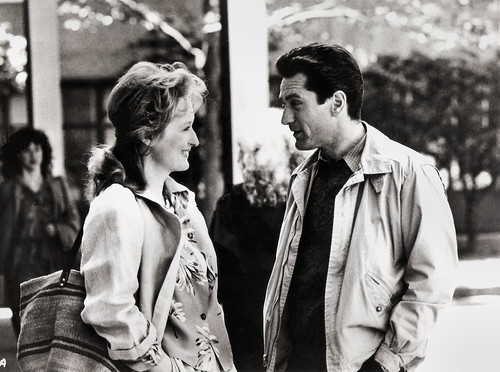
Vintage publicity photo. Meryl Streep and Robert De Niro in Falling in Love (Ulu Grosbard, 1984).
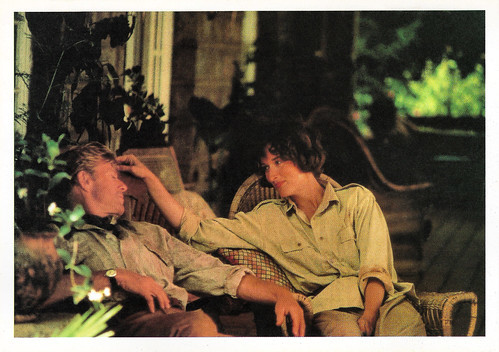
French postcard in the Collection Cinéma Couleur by Editions La Malibran, Paris, 1990, no. MC 41. Photo: Meryl Streep and Robert Redford in Out of Africa (Sydney Pollack, 1985).
Sources: Wikipedia and .

British postcard, no. 140.

American postcard by Fotofolio, New York, NY, no. P 432. Photo: Brigitte Lacombe, 1988.

Ukrainian postcard by Magicard.biz.ua. Meryl Streep in The Devil Wears Prada (David Frankel, 2006).
A real beauty bringing much freshness
Mary Louise 'Meryl' Streep was born in 1949, in Summit, New Jersey. She is the daughter of Mary Wilkinson Streep (née Mary Wolf Wilkinson), a commercial artist and art editor; and Harry William Streep, Jr., a pharmaceutical executive. She has two younger brothers: Harry William Streep III and Dana David Streep, who are also actors.
At the age of 12, Streep was selected to sing at a school recital, leading to her having opera lessons from Estelle Liebling. She quit after four years. Although Streep appeared in numerous school plays during her high school years, she was uninterested in serious theatre until acting in the play 'Miss Julie' at Vassar College in 1969, in which she gained attention across the campus.
She received her B.A. cum laude from the college in 1971, before applying for an MFA from the Yale School of Drama. Streep played a variety of roles on stage, from Helena in 'A Midsummer Night's Dream' to an 80-year-old woman in a wheelchair in a comedy written by then-unknown playwrights Christopher Durang and Albert Innaurato.
She received her MFA from Yale in 1975. That year, Streep made her stage debut in New York in 'Trelawny of the Wells' by Arthur Wing Pinero. The following year, she received a Tony Award nomination for Best Featured Actress in a Play for appearing in the 1976 double bill of '27 Wagons Full of Cotton' by Tennessee Williams and 'A Memory of Two Mondays' by Arthur Miller.
She made her screen debut in the television film The Deadliest Season (Robert Markowitz, 1977), a sports drama with Michael Moriarty. Her film debut was the award-winning Holocaust drama Julia (Fred Zinnemann, 1977), starring Jane Fonda and Vanessa Redgrave . It is based on a chapter from Lillian Hellman's book 'Pentimento' about the author's relationship with a lifelong friend, 'Julia,' who fought against the Nazis in the years prior to World War II. Streep had a small role during a flashback sequence.
She received her first Oscar nomination for the epic war drama The Deer Hunter (Michael Cimino, 1978). Critic Pauline Kael remarked that she was a "real beauty" who brought much freshness to the film with her performance. The film, starring Robert De Niro and Christopher Walken, was also successful at the box office, grossing $49 million.
She also won an Emmy Award for her role in the miniseries Holocaust (Marvin J. Chomsky, 1978), which recounts the trajectory of the Holocaust from the perspectives of the fictional Weiss family of German Jews and that of a rising member of the SS (Michael Moriarty), who gradually becomes a merciless war criminal.
Streep travelled to Germany and Austria for filming while her partner, actor John Cazale, who had been diagnosed with lung cancer, remained in New York. Upon her return, Streep found that Cazale's illness had progressed, and she nursed him until his death in March 1978.
Streep starred opposite Dustin Hoffman in the legal drama Kramer vs. Kramer (Robert Benton, 1979). It tells the story of a couple's divorce, its impact on their young son (Justin Henry), and the subsequent evolution of their relationship and views on parenting. For Kramer vs. Kramer, Streep won both the Golden Globe Award and the Academy Award for Best Supporting Actress, which she famously left in the ladies' room after giving her speech.

British postcard by Star Graphics, London, no. S 127.

British postcard. Photo: Meryl Streep and Jeremy Irons in The French Lieutenant's Woman (Karel Reisz, 1981).
Portraying a Polish survivor of Auschwitz
Meryl Streep's first leading role was in the British romantic drama The French Lieutenant's Woman (Karel Reisz, 1981), a story within a story drama. The film paired Streep with Jeremy Irons as contemporary actors, telling their modern story, as well as the Victorian era drama they were performing. She got an Oscar nomination for her performance.
Streep won the Oscar for Best Actress for Sophie's Choice (Alan J. Pakula, 1982). Streep was very determined to get the role. After obtaining a bootlegged copy of the script, she went after Pakula, and threw herself on the ground, begging him to give her the part. She portrayed a Polish survivor of Auschwitz, caught in a love triangle between a young naïve writer (Peter MacNicol) and a Jewish intellectual (Kevin Kline).
Janet Maslin of The New York Times wrote: "Though it's far from a flawless movie, 'Sophie's Choice' is a unified and deeply affecting one. Thanks in large part to Miss Streep's bravura performance, it's a film that casts a powerful, uninterrupted spell."
In 1983, Streep played her first non-fictional character, the nuclear whistleblower and labor union activist Karen Silkwood, who died in a suspicious car accident while investigating alleged wrongdoing at the Kerr-McGee plutonium plant, in Mike Nichols' biographical drama Silkwood (Mike Nichols, 1983) with Cher.
Then she portrayed a fighter for the French Resistance during World War II in the British drama Plenty (Fred Schepisi, 1985), adapted from the play by David Hare. Her next release, the epic romantic drama Out of Africa (Sydney Pollack, 1985), established her as a Hollywood superstar. In the film, Streep starred as the Danish writer Karen Blixen, opposite Robert Redford's Denys Finch Hatton. It earned her another Oscar nomination.
Karina Longworth notes in 'Meryl Streep: Anatomy of an Actor' (2013) that the dramatic success of Out of Africa led to a backlash of critical opinion against Streep in the years that followed, especially as she was now demanding $4 million a picture. Unlike other stars at the time, such as Sylvester Stallone and Tom Cruise, Streep "never seemed to play herself", and certain critics felt her technical finesse led people to literally see her acting.

French postcard by Editions "Humour à la Carte", Paris, no. ST-121. Photo: Meryl Streep in Plenty (Fred Schepisi, 1985).

Romanian postcard by Acin in the Colectia Cinefilului.
One of the greatest performances of her career
Meryl Streep's other Oscar-nominated roles were in Ironweed (Héctor Babenco, 1987) with Jack Nicholson , the Australian drama Evil Angels/A Cry in the Dark (Fred Schepisi, 1988), the comedy-drama Postcards from the Edge (Mike Nichols, 1990) with Shirley MacLaine, the romantic drama The Bridges of Madison County (Clint Eastwood, 1995), One True Thing (Carl Franklin, 1998) with Renee Zellweger, the musical drama Music of the Heart (Wes Craven, 1999), Adaptation (Spike Jonze, 2002) starring Nicholas Cage, the comedy-drama The Devil Wears Prada (David Frankel, 2006) with Anne Hathaway, the period drama Doubt (John Patrick Shanley, 2008), the comedy-drama Julie & Julia (Nora Ephron, 2009) with Amy Adams, August: Osage County (John Wells, 2013) with Julia Roberts, the musical fantasy Into the Woods (Rob Marshall, 2014), the biographical comedy-drama Florence Foster Jenkins (Stephen Frears, 2016) with Hugh Grant , and the historical political thriller The Post (Steven Spielberg, 2017), starring Tom Hanks.
Streep won the Best Actress Oscar again for The Iron Lady (Phyllida Lloyd, 2011), the British-French biographical drama based on the life and career of Margaret Thatcher. While the film was met with mixed reviews, Streep's performance was widely acclaimed and considered to be one of the greatest of her career.
Her stage roles include The Public Theater's 2001 revival of 'The Seagull', and her television roles include two projects for HBO, the acclaimed miniseries Angels in America (Mike Nichols, 2003), for which her performance won her another Emmy Award, and the drama series Big Little Lies (Andrea Arnold, 2019). Streep has also been the recipient of many honorary awards. She was awarded Commander of the Order of the Arts and Letters by French culture minister Jean-Jacques Aillagon in 2003.
In the cinema, she appeared as Emmeline Pankhurst, a British political activist, and leader of the British suffragette movement who helped women win the right to vote in the period drama Suffragette (Sarah Gavron, 2015), co-starring Carey Mulligan and Helena Bonham Carter. Streep reprised the role of Donna Sheridan in the musical sequel Mamma Mia! Here We Go Again (Ol Parker, 2018). She also played a supporting part in Mary Poppins Returns (Rob Marshall, ), starring Emily Blunt in the title role.
In 2019, she starred in the biographical comedy The Laundromat (Steven Soderberg, 2019), the first Netflix film in which Streep starred. The film focused on the Panama Papers in particular and Beneficial ownership in general. Streep was whistleblower John Doe who released incriminating documents to the media. In addition, she played Aunt March in Little Women (Greta Gerwig, 2019).
Despite her stardom, for decades Streep has managed to maintain a relatively normal personal life. Streep lived with actor John Cazale for three years until his death from lung cancer in March 1978. Streep married sculptor Don Gummer six months after Cazale's death. They have four children: one son and three daughters, son Henry Wolfe Gummer (1979), a musician; daughters Mary Willa 'Mamie' Gummer (1983), an actress; Grace Jane Gummer (1986), an actress; and Louisa Jacobson Gummer (1991), a model. In February 2019, Streep became a grandmother for the first time, through her eldest daughter Mamie.

Vintage publicity photo. Meryl Streep and Robert De Niro in Falling in Love (Ulu Grosbard, 1984).

French postcard in the Collection Cinéma Couleur by Editions La Malibran, Paris, 1990, no. MC 41. Photo: Meryl Streep and Robert Redford in Out of Africa (Sydney Pollack, 1985).
Sources: Wikipedia and .
Published on April 16, 2020 22:00
April 15, 2020
Gina Palerme
French actress and singer Gina Palerme (1885-1977) was the toast of the London music halls in the 1910s. In the next decade, she played in numerous French silent films and finished her career in the Moulin Rouge and other Paris cabarets.
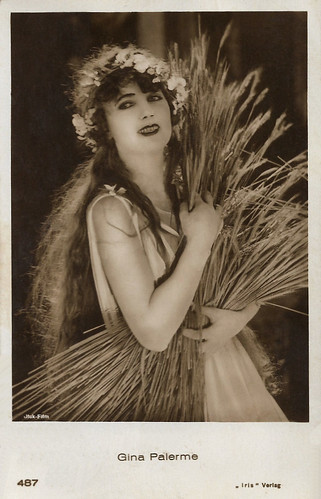
Austrian postcard by Iris Verlag, no. 487. Photo: Ifuk-Film.
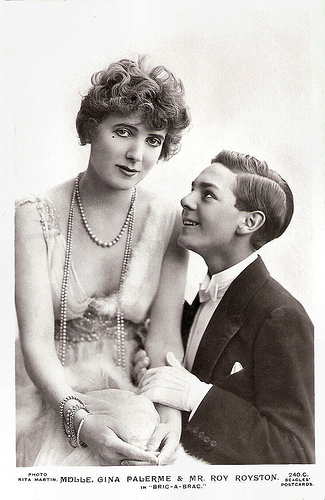
British postcard by J. Beagles & Co, London, no. 240 C. Photo: Rita Martin. Publicity still for the stage production Bric-a-brac (1915) with Roy Royston.
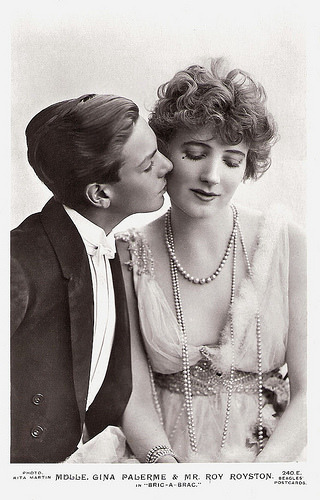
British postcard by J. Beagles & Co, London, no. 240 E. Photo: Rita Martin. Publicity still for the stage production Bric-a-brac (1915) again with Roy Royston.
The Glamour of the French Cocotte
Gina Palerme was born Marie Louise Irène de Maulmont in Bussière-Galant in the West of France in 1885.
In 1911, she was discovered by a British entrepreneur and debuted as Toinette in the musical comedy The Quaker Girl (1911) directed by Lionel Mockton at the Adelphi Theatre.
Her début was followed by appearances in West-end productions like The Dancing Mistress (1912), Betty (1914), Platons Les Capucines (1914), Bric-a-Brac (1915), Vanity Fair (1916), La Petite Chocolatière (1917), Finsbury (1917), and The Girl for the Boy (1919).
Until 1919, Palerme was the toast of the London music hall. Cecil Beaton enthusiastically wrote about her: “Gina Palerme brought the glamour of the French cocotte to London. Her off-stage appearances were as sensational as her stage escapades...sometimes she wore a velvet tam-o'-shanter and men's riding breeches while relaxing in the richly ornate gilt of her Maida Vale drawing-room.”
The National Portrait Gallery holds beautiful photos from those years, made by the famous photographer Bassano and by his colleagues Rita Martin and The Dover Street Studios Ltd.
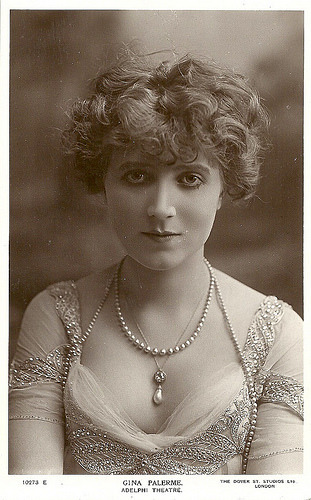
British postcard, no. 10273 E. Photo: The Dover Street Studios Ltd, London.
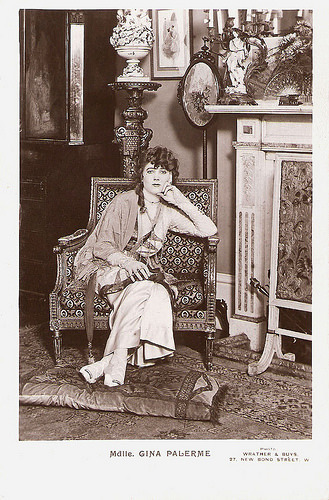
British postcard. Photo: Wrather & Buys, London.
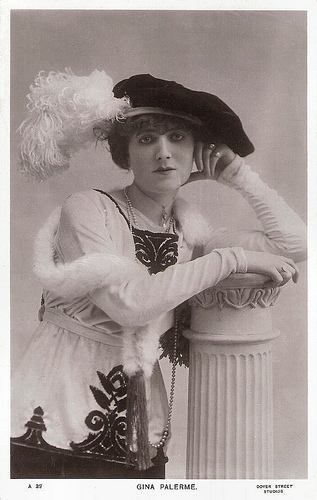
British postcard in the Arcadian Series, no. A 39. Photo: Dover Street Studios.
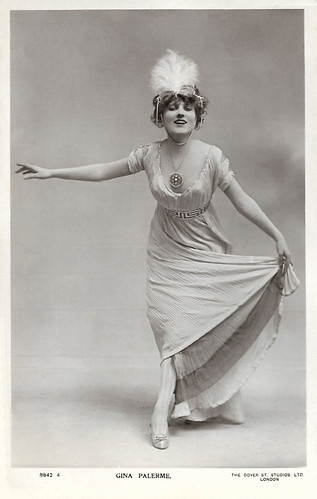
British postcard, no. 8842 4. Photo: Dover Street Studios LTD, London.
Horror Comedy
Gina Palerme returned to France in 1919.
In the early 1920s she played in various silent French films like L’éternel féminin/The Eternal Female (Roger Lion, 1921), Margot (Guy du Fresnay, 1922), L’idée de Françoise/Françoise's Idea (Robert Saidreau, 1923) in which she played the title role of the foreseeing Françoise, and the Halevy & Meilhac adaptation Frou-Frou (Guy du Fresnay, 1923).
La bataille/The Danger Line (1923) was co-directed by Edouard-Emile Viollet and Hollywood star Sessue Hayakawa who also played the male lead, together with his wife Tsuru Aoki.
In the horror-comedy Au secours!/Help! (Abel Gance, 1924) she co-starred with the great comic Max Linder . It was his last surviving work;
Her final film was La clé de voute/The Keystone (Roger Lion, 1925), which Palerme produced herself. It was a drama about a young female factory worker who gives away her child but always repents.
After this film, Gina Palerme quitted the cinema. From then on, she would only work in such French cabarets as the Moulin Rouge and the Concert Mayol.
Gina Palerme died a natural death in 1977 in Les Pavillons-sous-Bois, France.
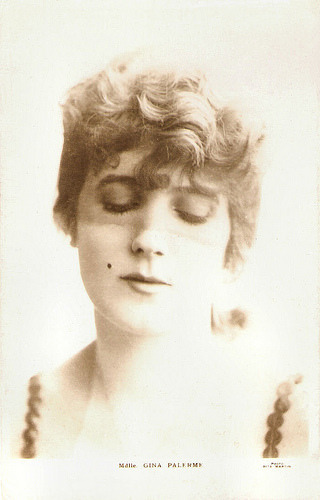
British postcard. Photo: Rita Martin.
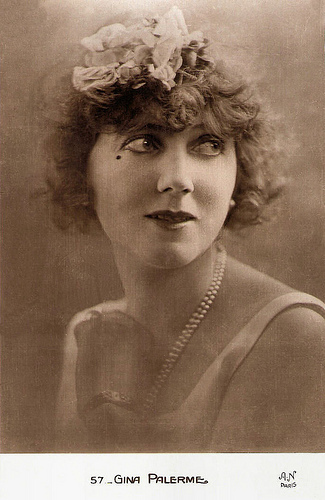
French postcard by A.N., Paris, no. 57.
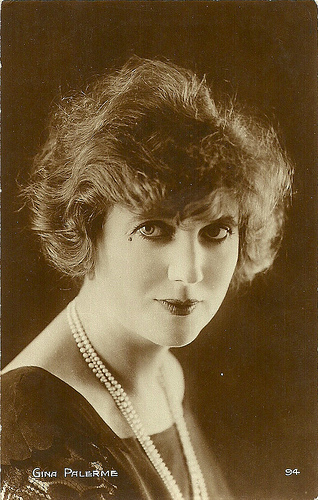
French postcard by Cinémagazine, no. 94.
Sources: John Culme (Footlight Notes), National Portrait Gallery, Les Gens du Cinema (French) and . And with thanks to Marlene Pilaete.

Austrian postcard by Iris Verlag, no. 487. Photo: Ifuk-Film.

British postcard by J. Beagles & Co, London, no. 240 C. Photo: Rita Martin. Publicity still for the stage production Bric-a-brac (1915) with Roy Royston.

British postcard by J. Beagles & Co, London, no. 240 E. Photo: Rita Martin. Publicity still for the stage production Bric-a-brac (1915) again with Roy Royston.
The Glamour of the French Cocotte
Gina Palerme was born Marie Louise Irène de Maulmont in Bussière-Galant in the West of France in 1885.
In 1911, she was discovered by a British entrepreneur and debuted as Toinette in the musical comedy The Quaker Girl (1911) directed by Lionel Mockton at the Adelphi Theatre.
Her début was followed by appearances in West-end productions like The Dancing Mistress (1912), Betty (1914), Platons Les Capucines (1914), Bric-a-Brac (1915), Vanity Fair (1916), La Petite Chocolatière (1917), Finsbury (1917), and The Girl for the Boy (1919).
Until 1919, Palerme was the toast of the London music hall. Cecil Beaton enthusiastically wrote about her: “Gina Palerme brought the glamour of the French cocotte to London. Her off-stage appearances were as sensational as her stage escapades...sometimes she wore a velvet tam-o'-shanter and men's riding breeches while relaxing in the richly ornate gilt of her Maida Vale drawing-room.”
The National Portrait Gallery holds beautiful photos from those years, made by the famous photographer Bassano and by his colleagues Rita Martin and The Dover Street Studios Ltd.

British postcard, no. 10273 E. Photo: The Dover Street Studios Ltd, London.

British postcard. Photo: Wrather & Buys, London.

British postcard in the Arcadian Series, no. A 39. Photo: Dover Street Studios.

British postcard, no. 8842 4. Photo: Dover Street Studios LTD, London.
Horror Comedy
Gina Palerme returned to France in 1919.
In the early 1920s she played in various silent French films like L’éternel féminin/The Eternal Female (Roger Lion, 1921), Margot (Guy du Fresnay, 1922), L’idée de Françoise/Françoise's Idea (Robert Saidreau, 1923) in which she played the title role of the foreseeing Françoise, and the Halevy & Meilhac adaptation Frou-Frou (Guy du Fresnay, 1923).
La bataille/The Danger Line (1923) was co-directed by Edouard-Emile Viollet and Hollywood star Sessue Hayakawa who also played the male lead, together with his wife Tsuru Aoki.
In the horror-comedy Au secours!/Help! (Abel Gance, 1924) she co-starred with the great comic Max Linder . It was his last surviving work;
Her final film was La clé de voute/The Keystone (Roger Lion, 1925), which Palerme produced herself. It was a drama about a young female factory worker who gives away her child but always repents.
After this film, Gina Palerme quitted the cinema. From then on, she would only work in such French cabarets as the Moulin Rouge and the Concert Mayol.
Gina Palerme died a natural death in 1977 in Les Pavillons-sous-Bois, France.

British postcard. Photo: Rita Martin.

French postcard by A.N., Paris, no. 57.

French postcard by Cinémagazine, no. 94.
Sources: John Culme (Footlight Notes), National Portrait Gallery, Les Gens du Cinema (French) and . And with thanks to Marlene Pilaete.
Published on April 15, 2020 22:00
Paul van Yperen's Blog
- Paul van Yperen's profile
- 13 followers
Paul van Yperen isn't a Goodreads Author
(yet),
but they
do have a blog,
so here are some recent posts imported from
their feed.



